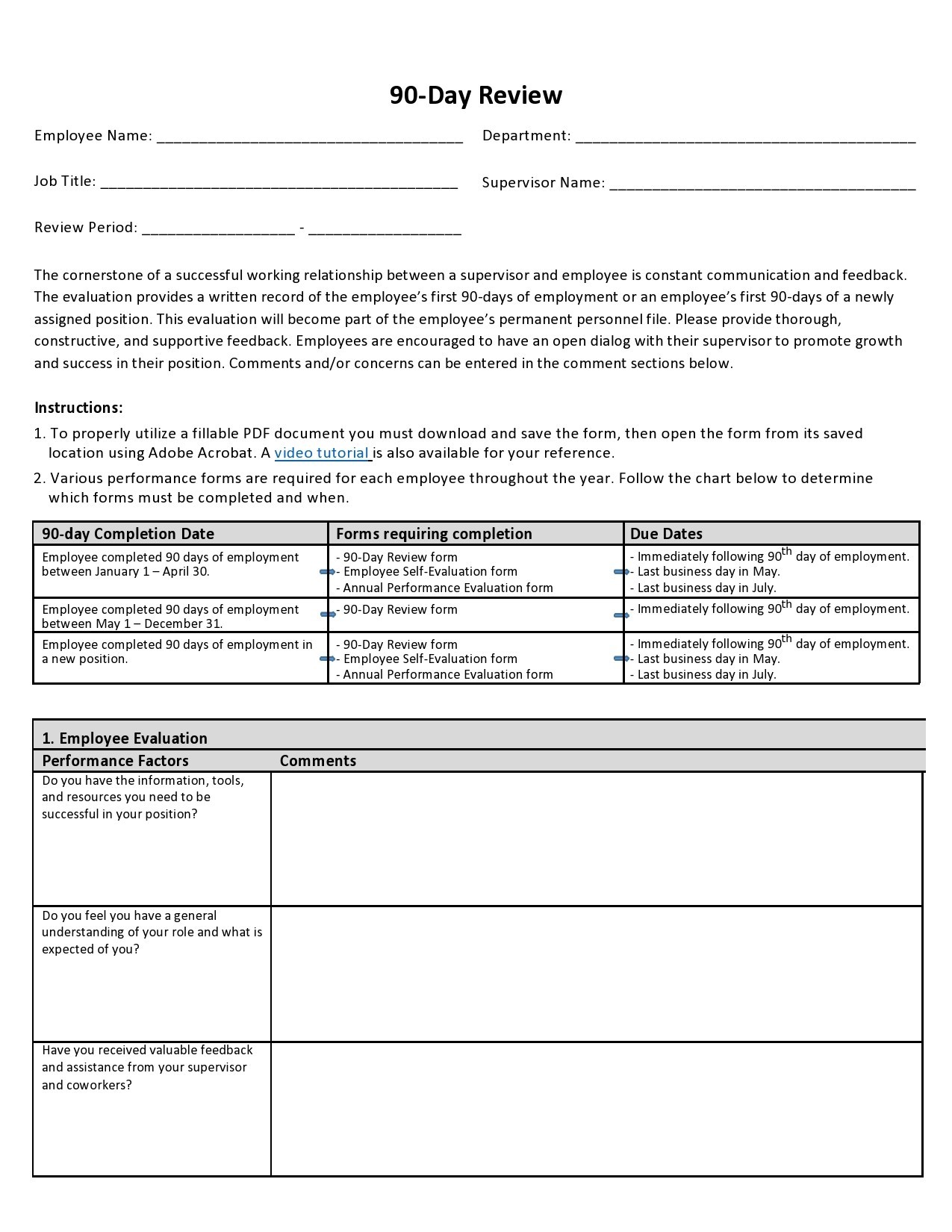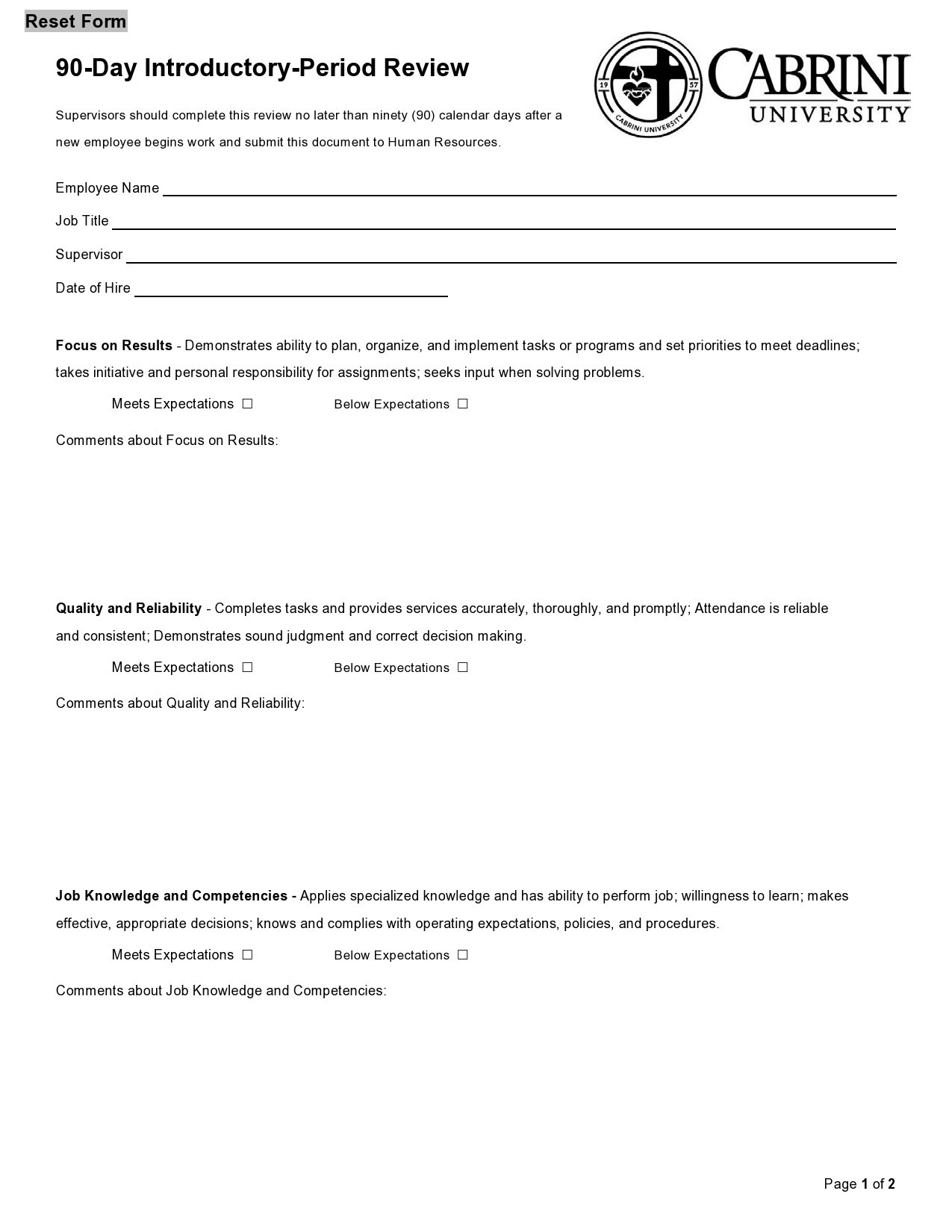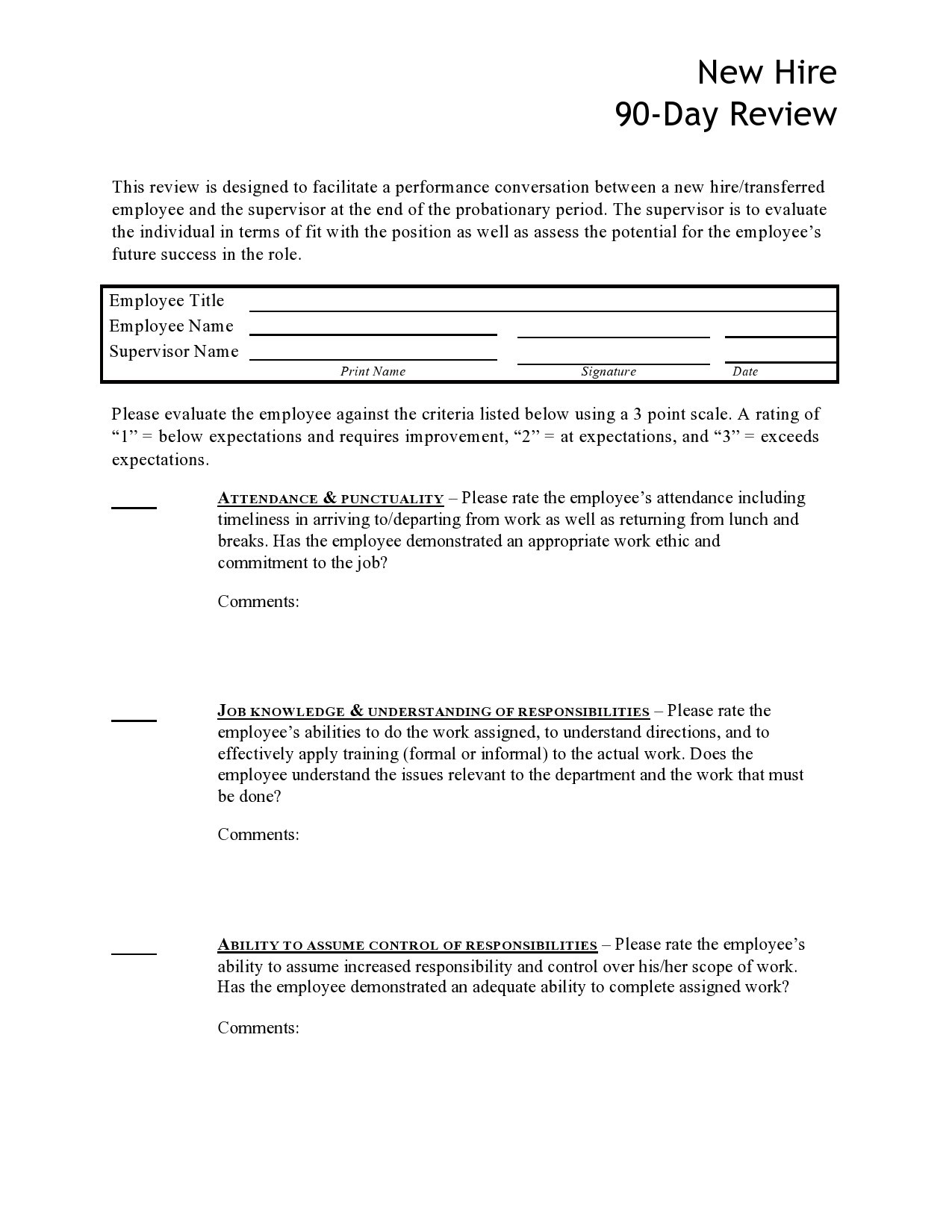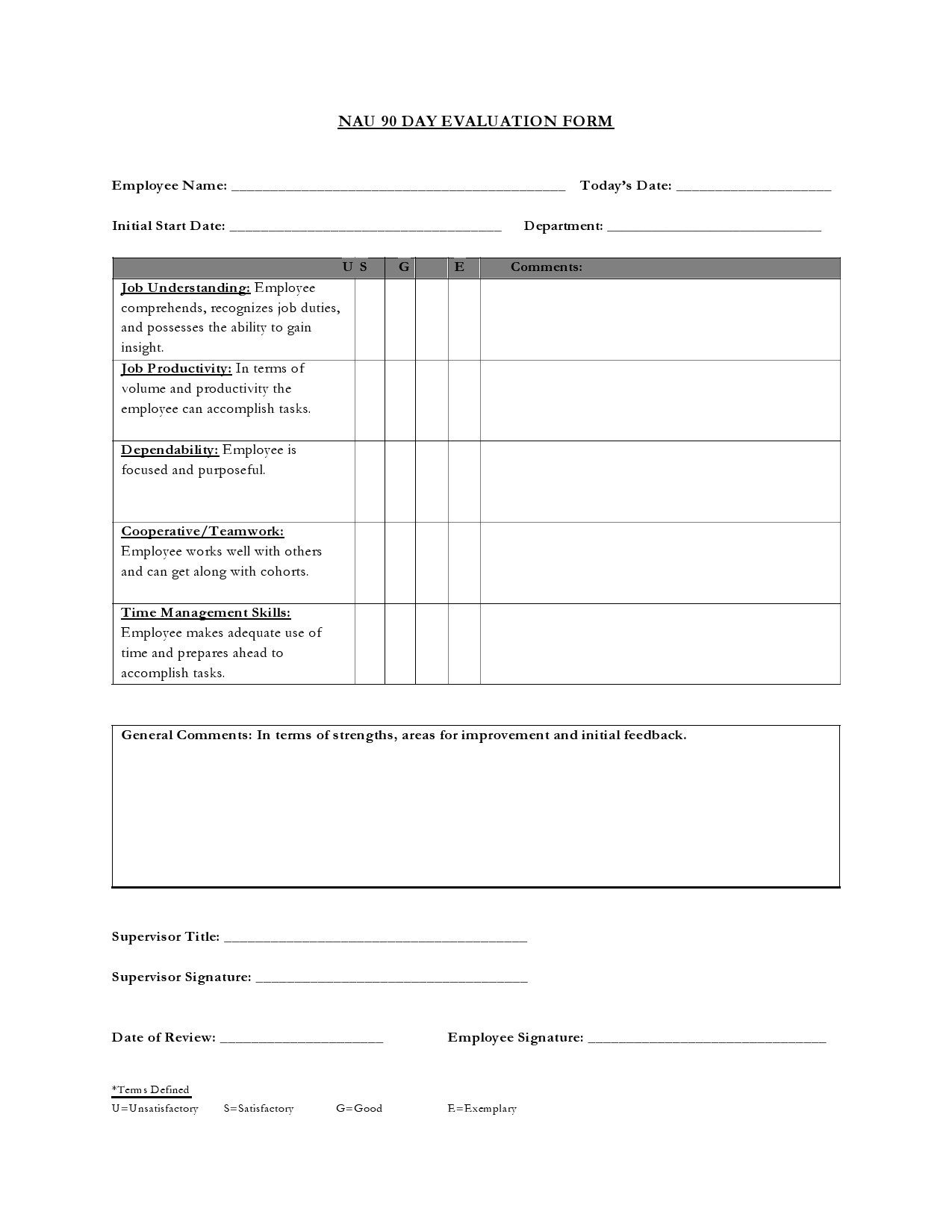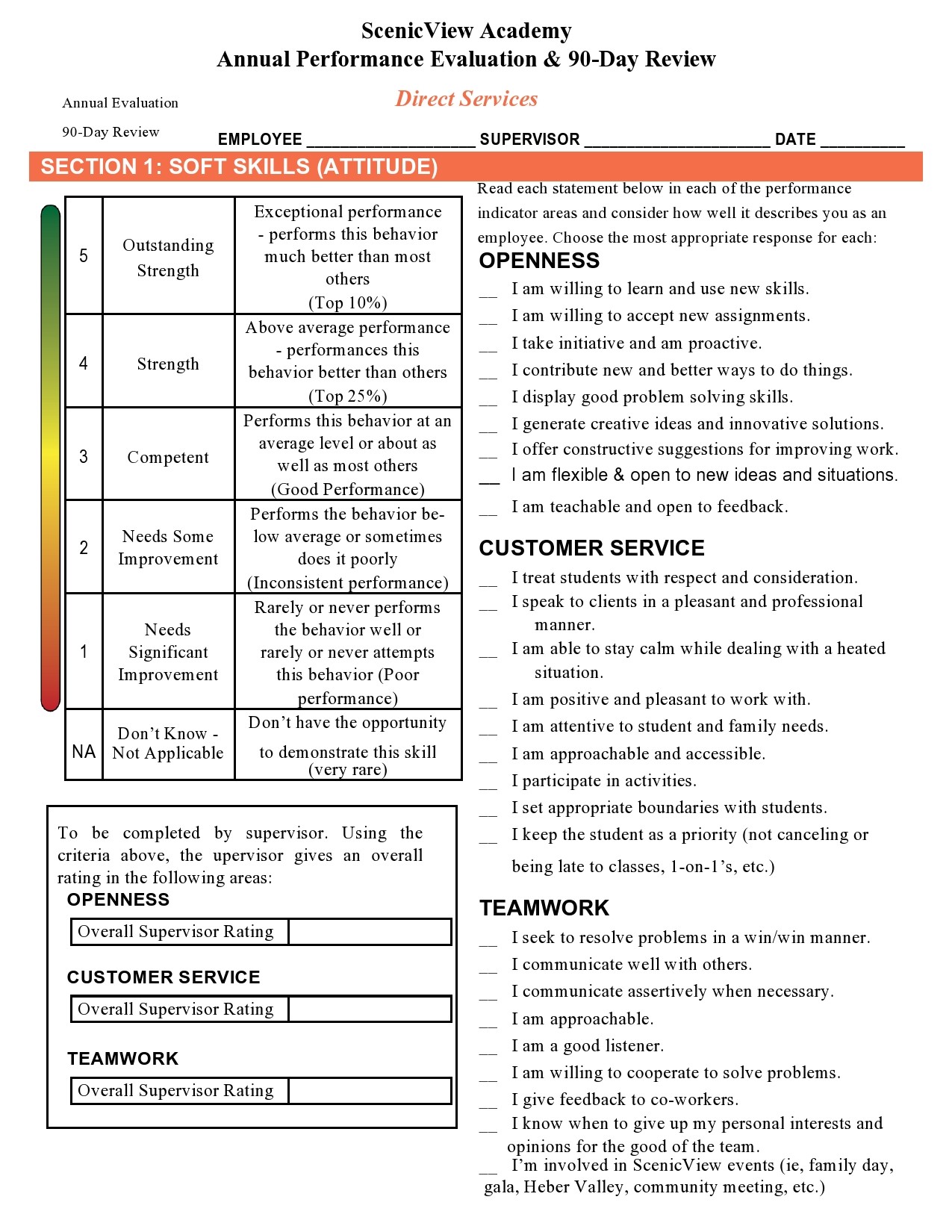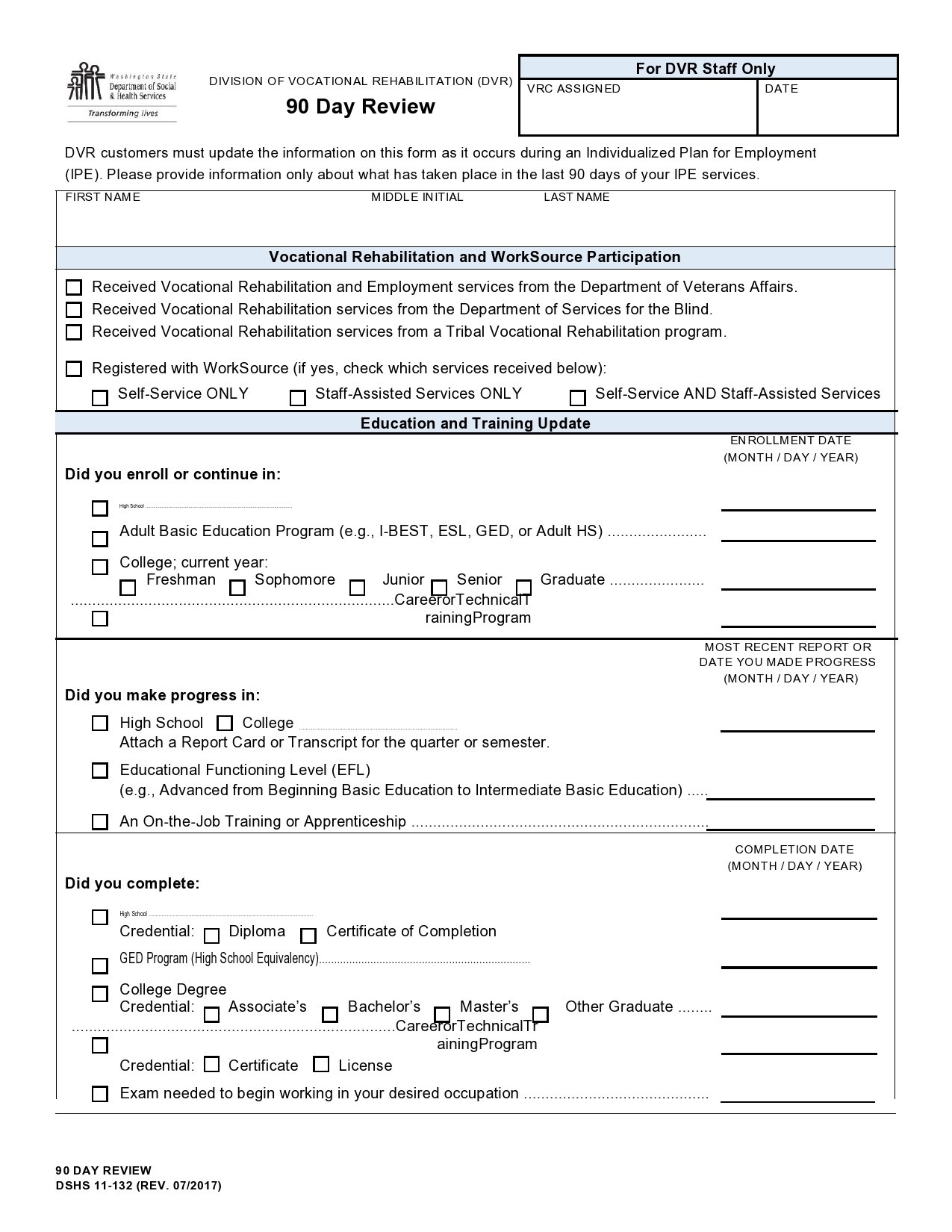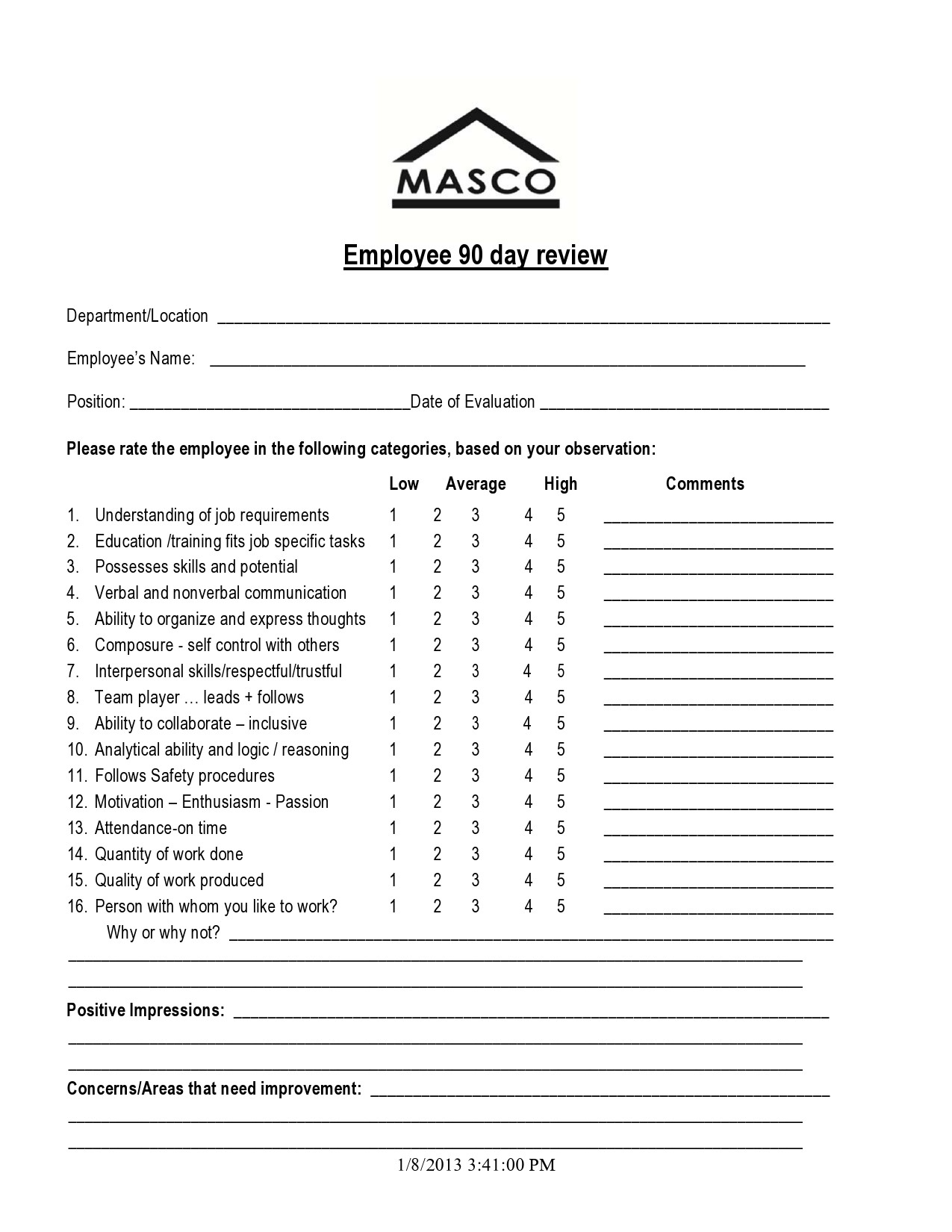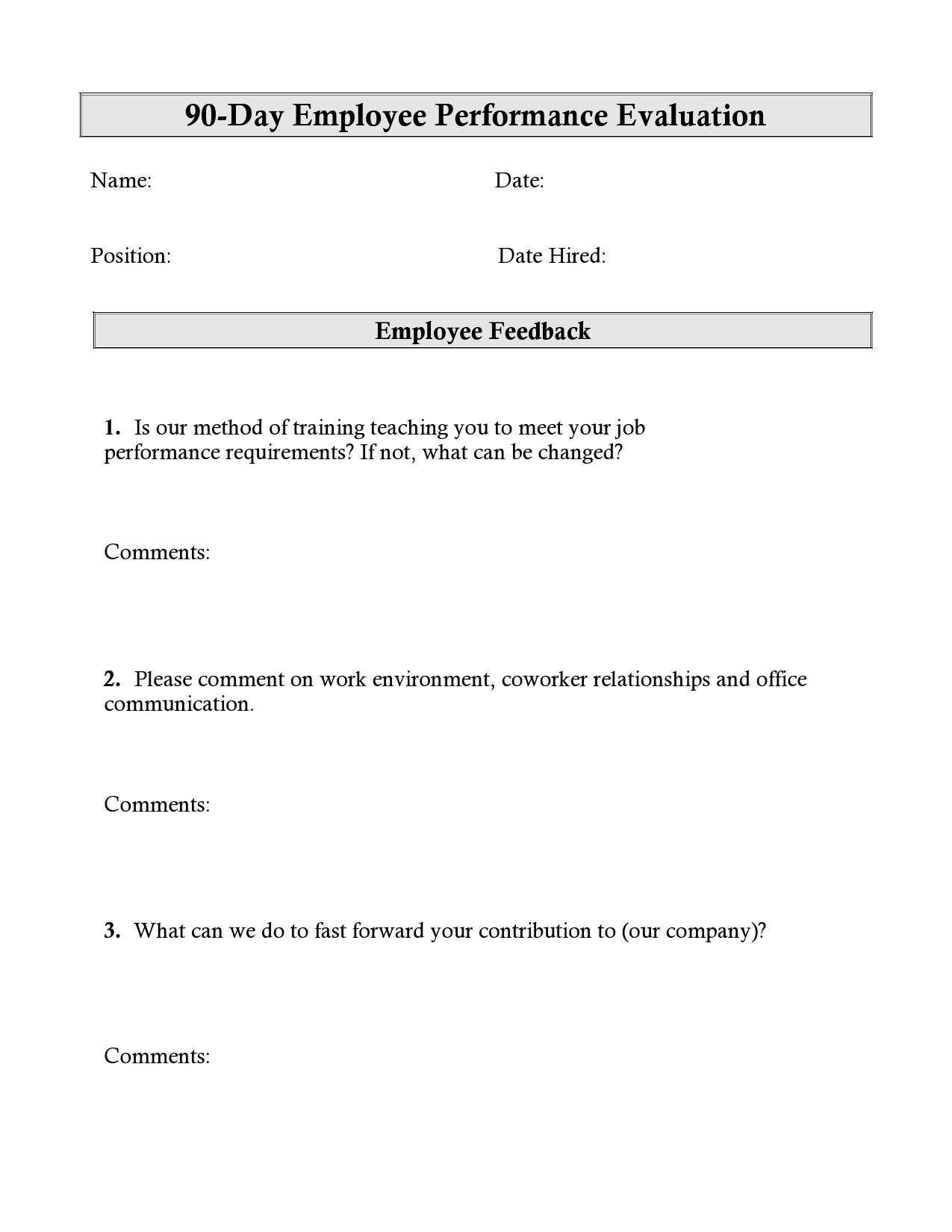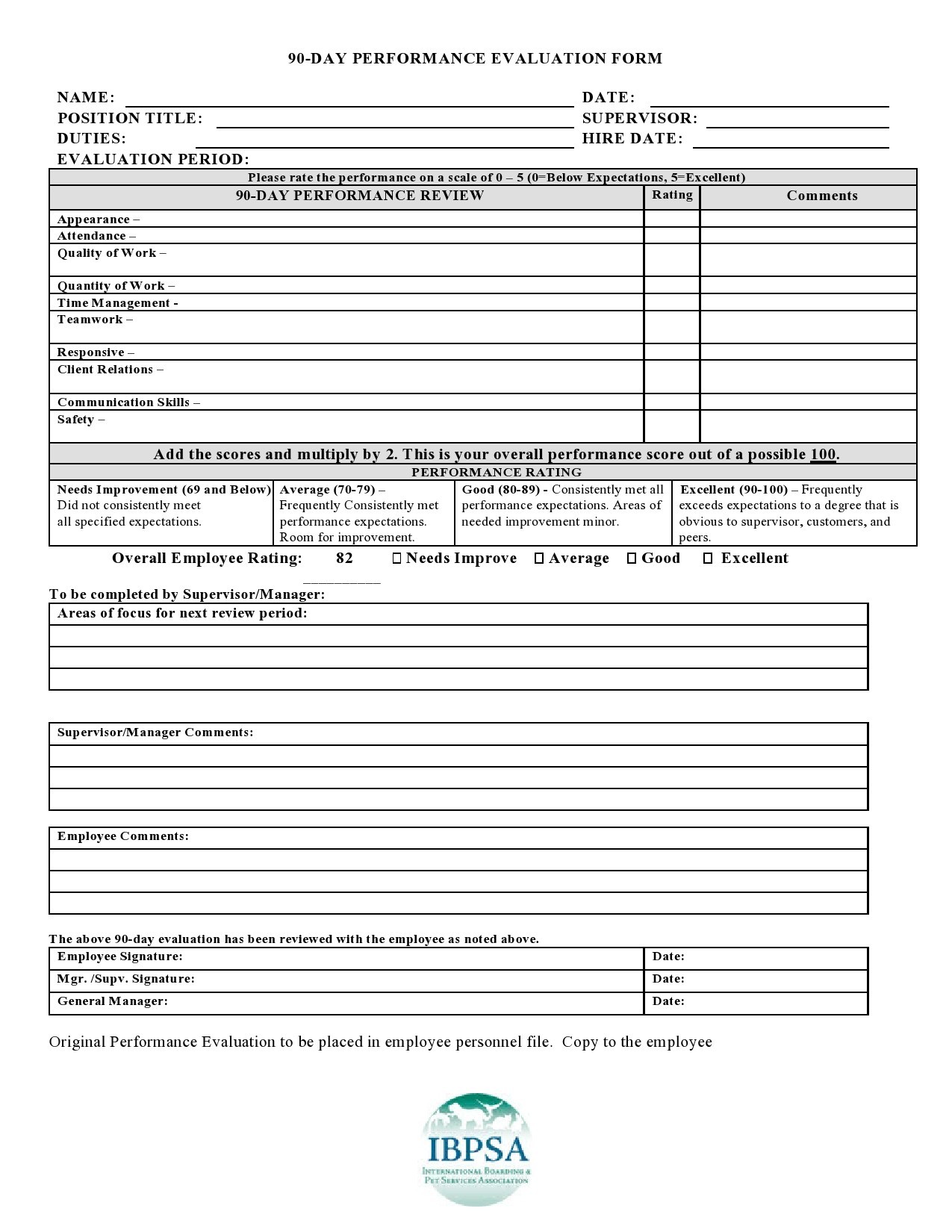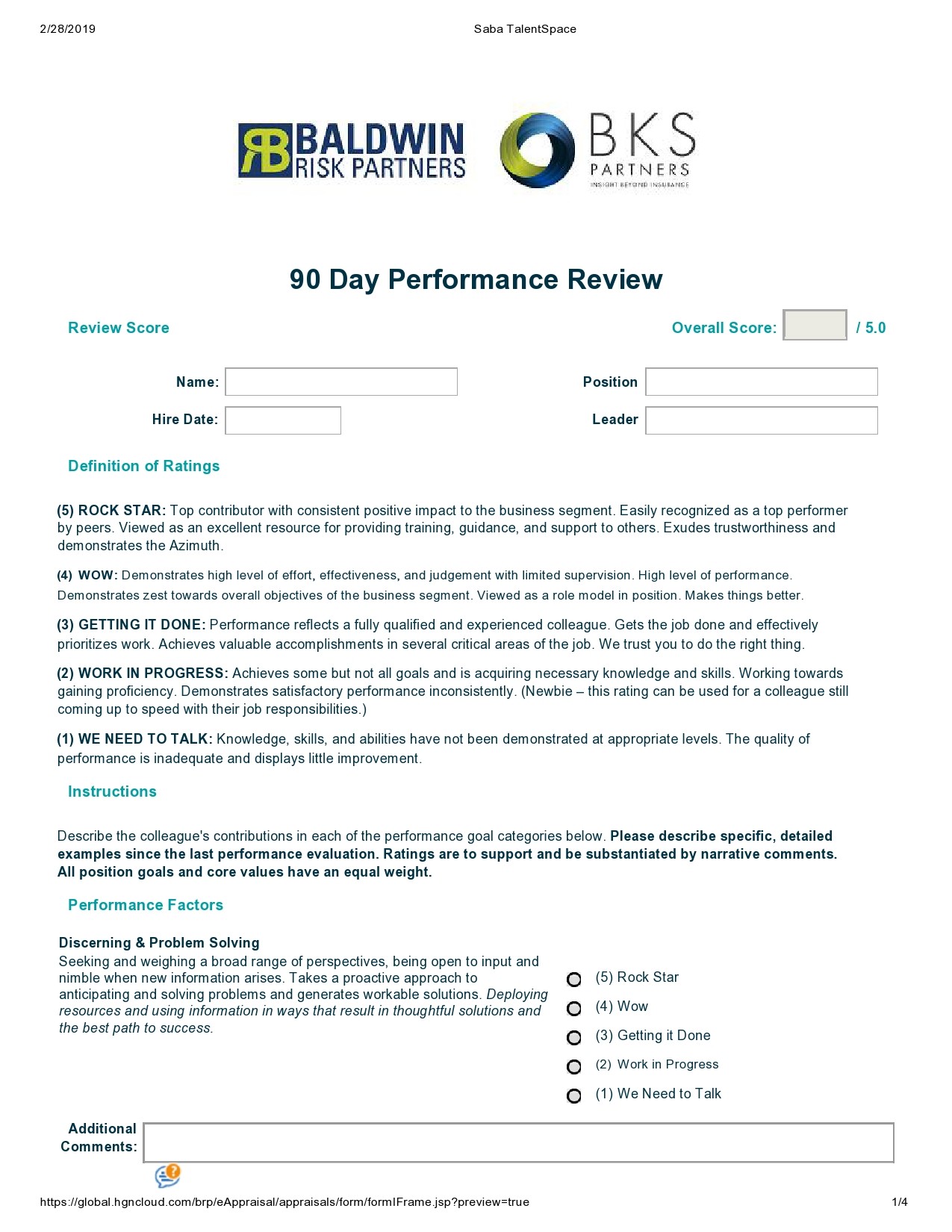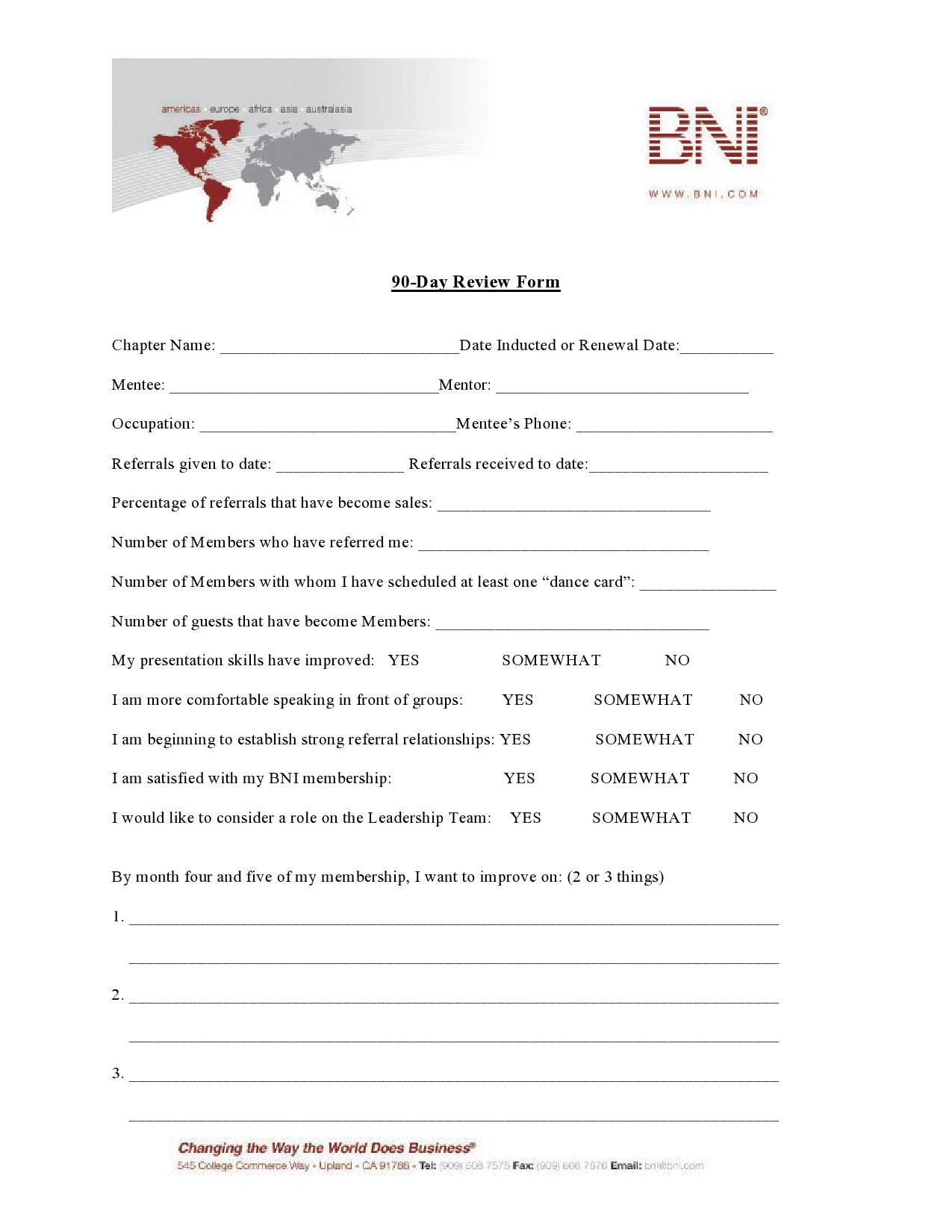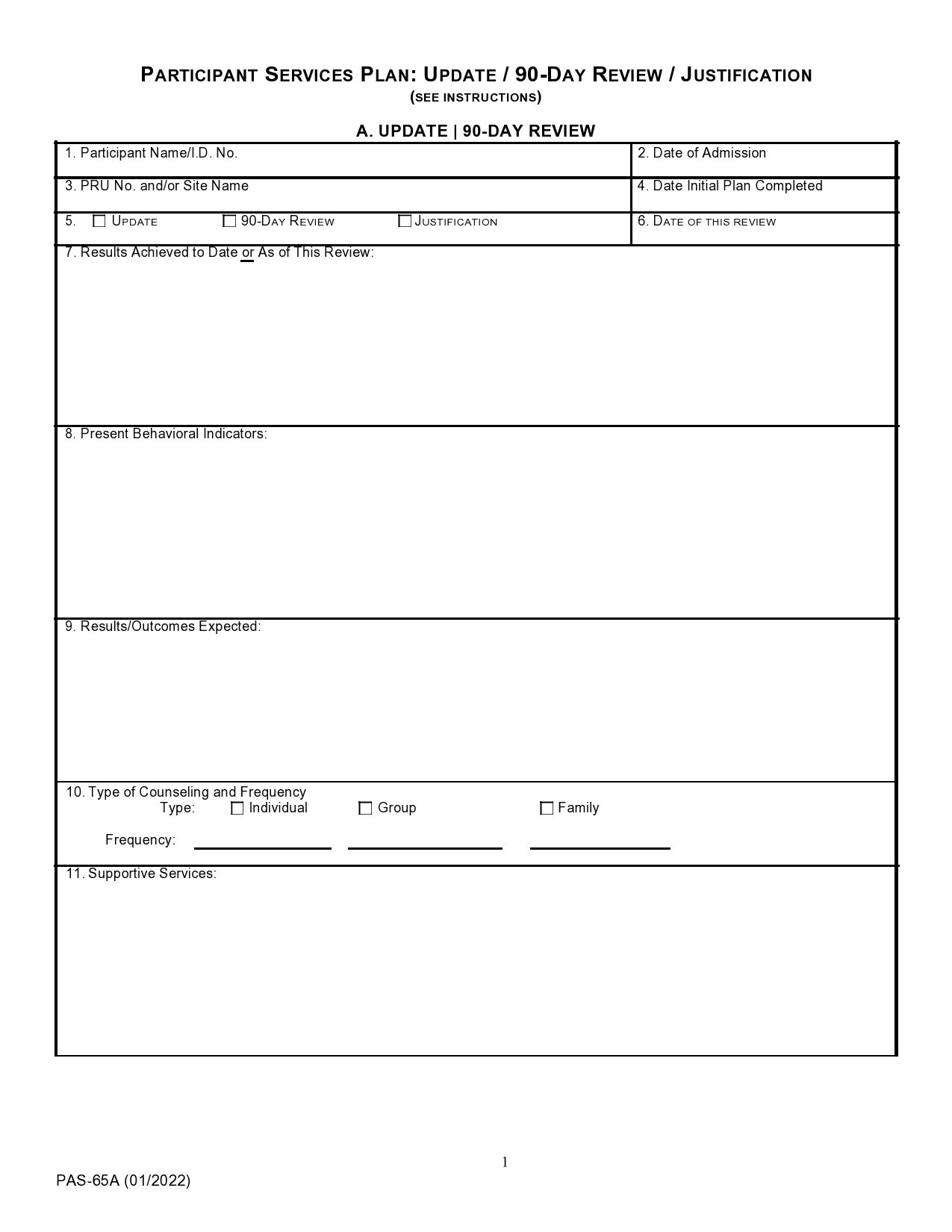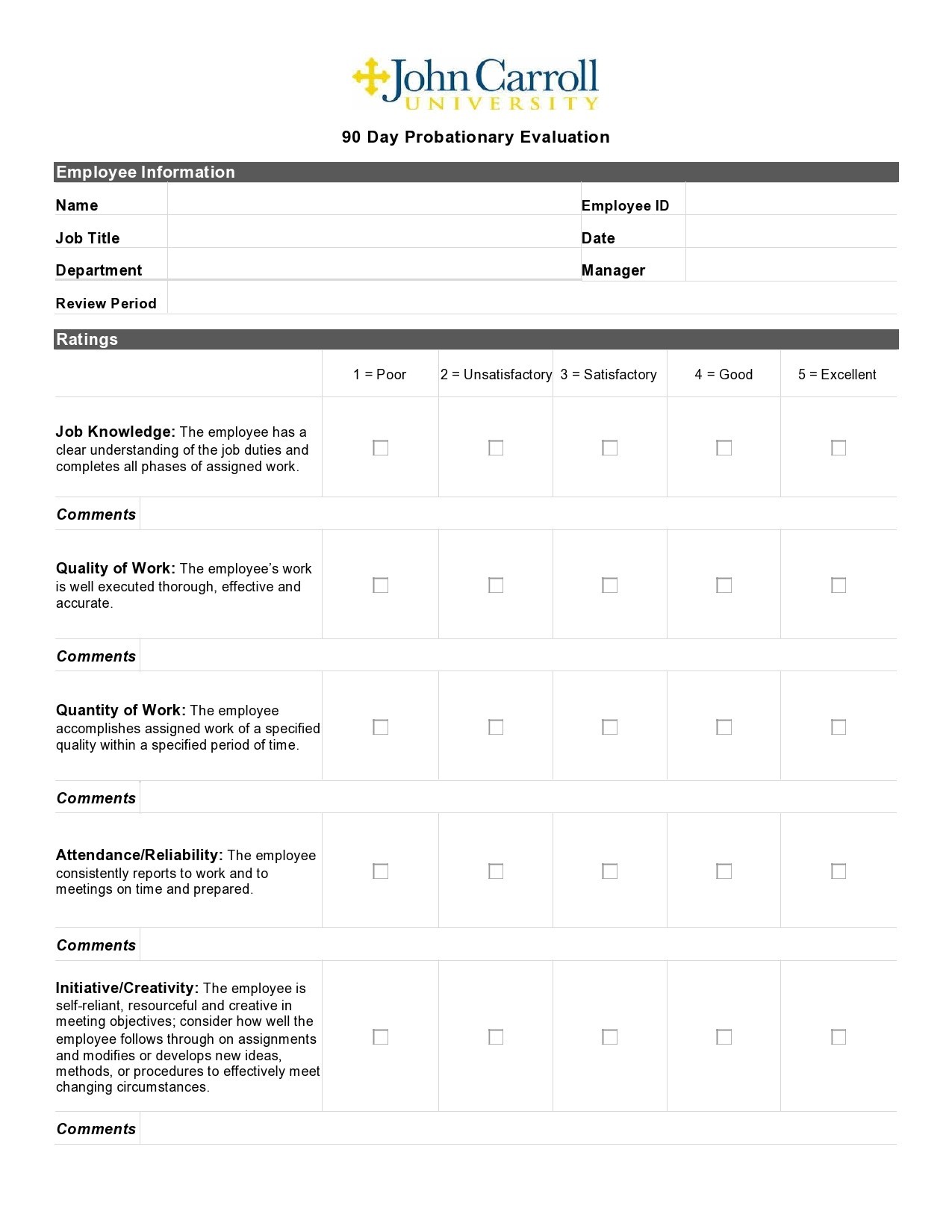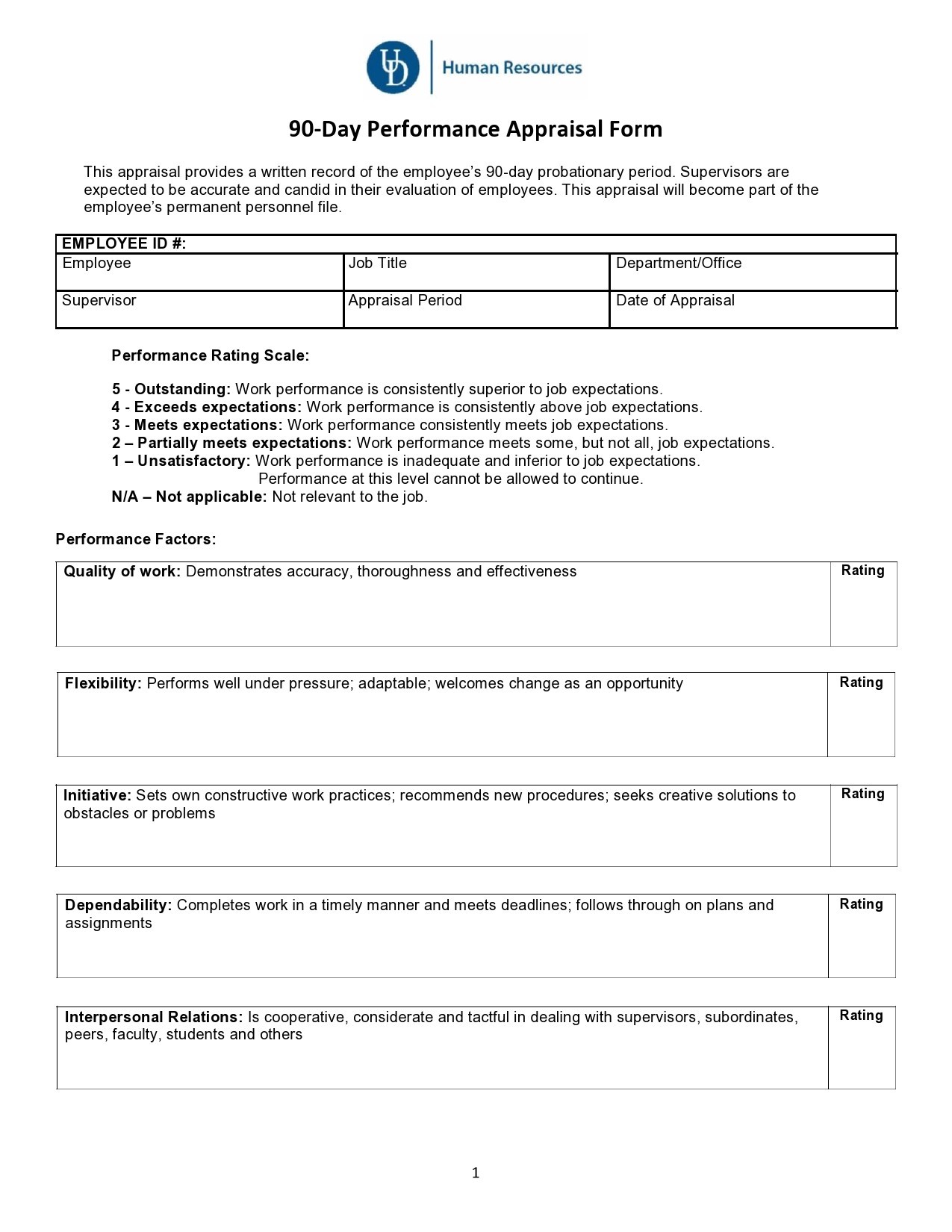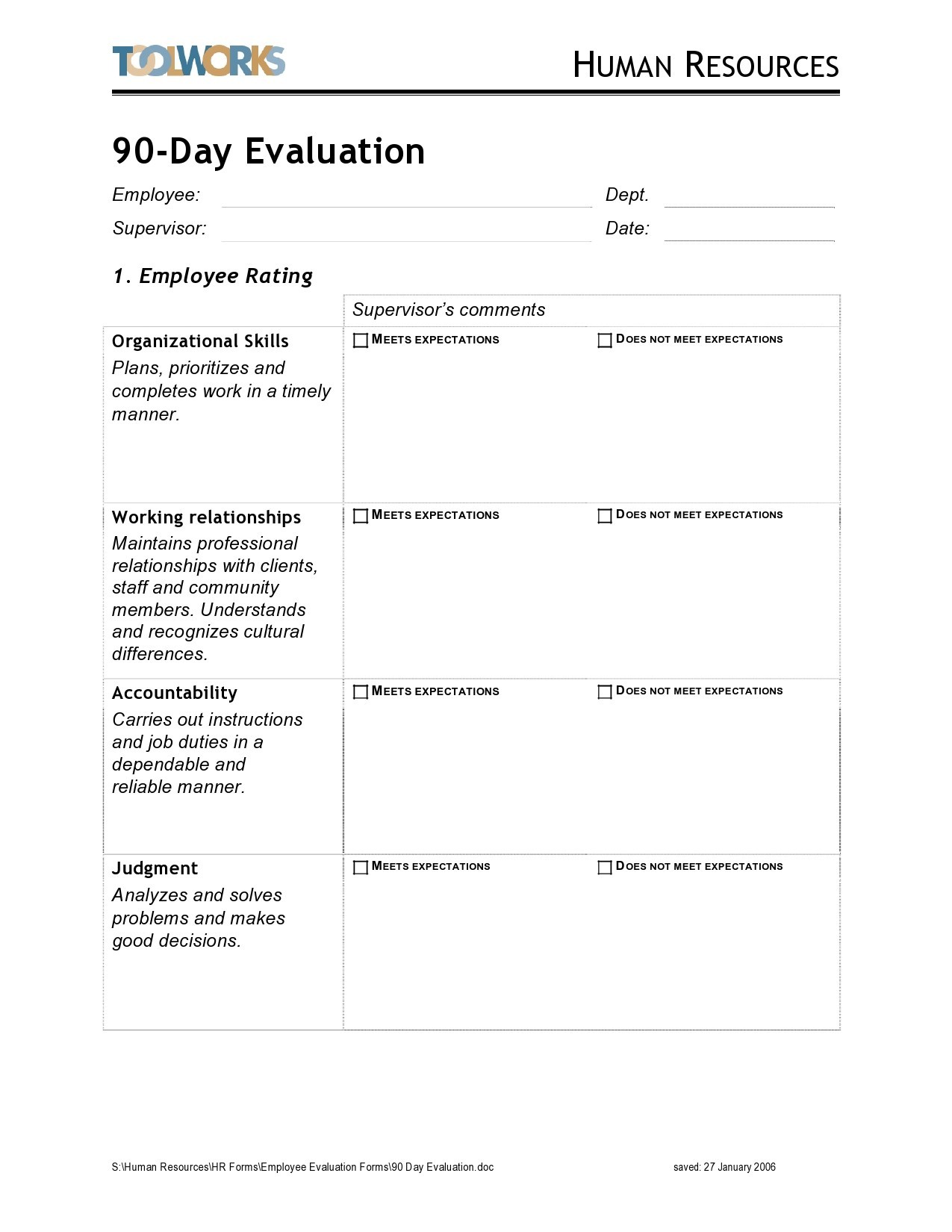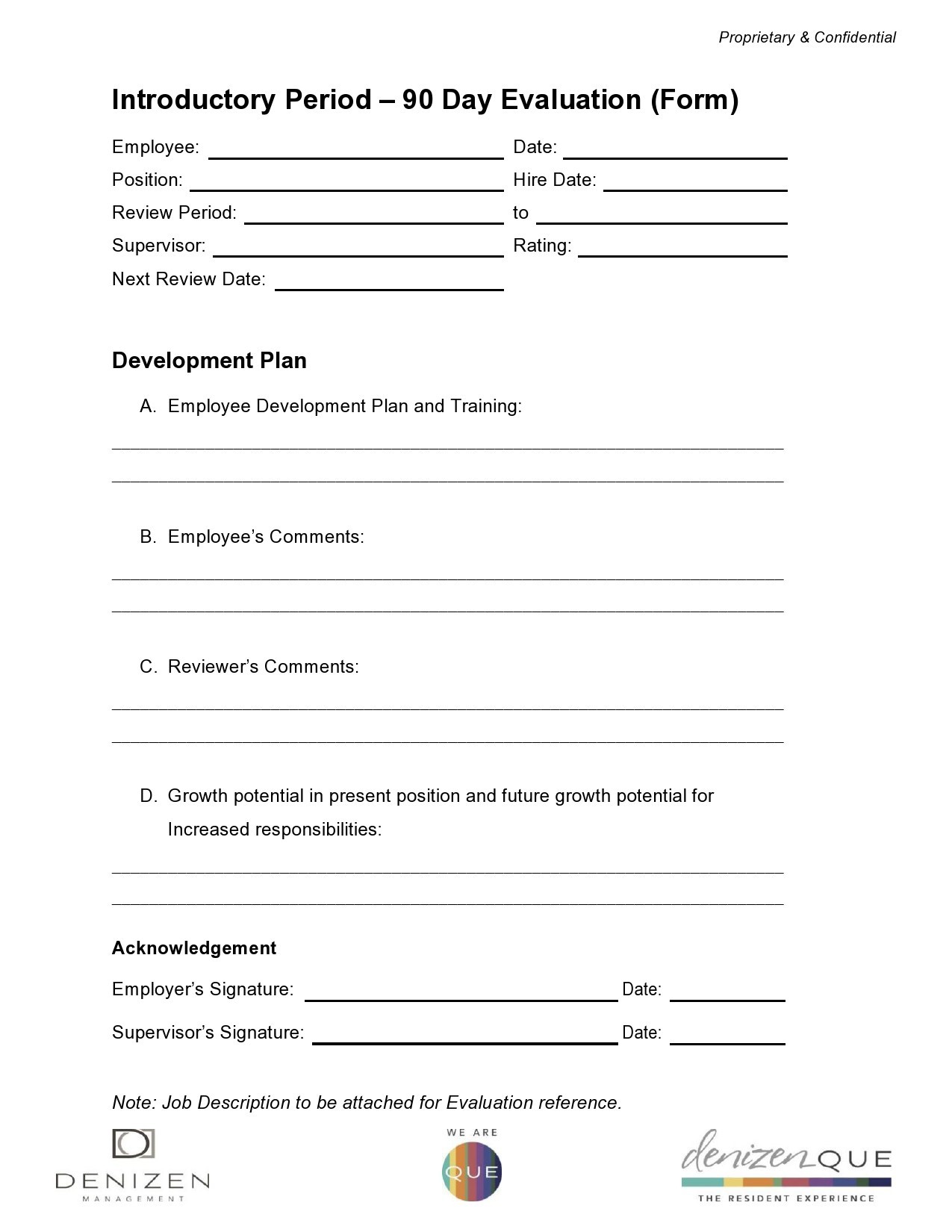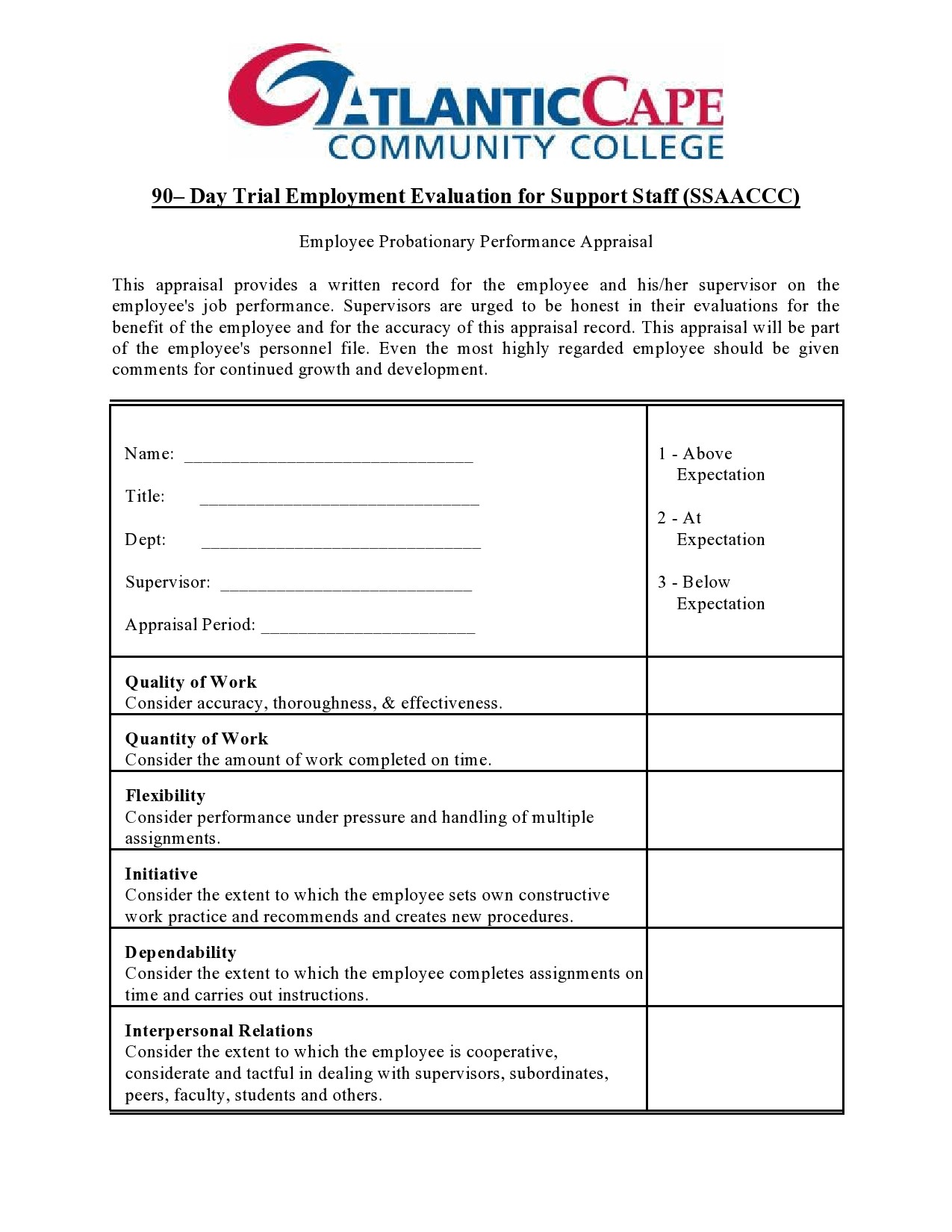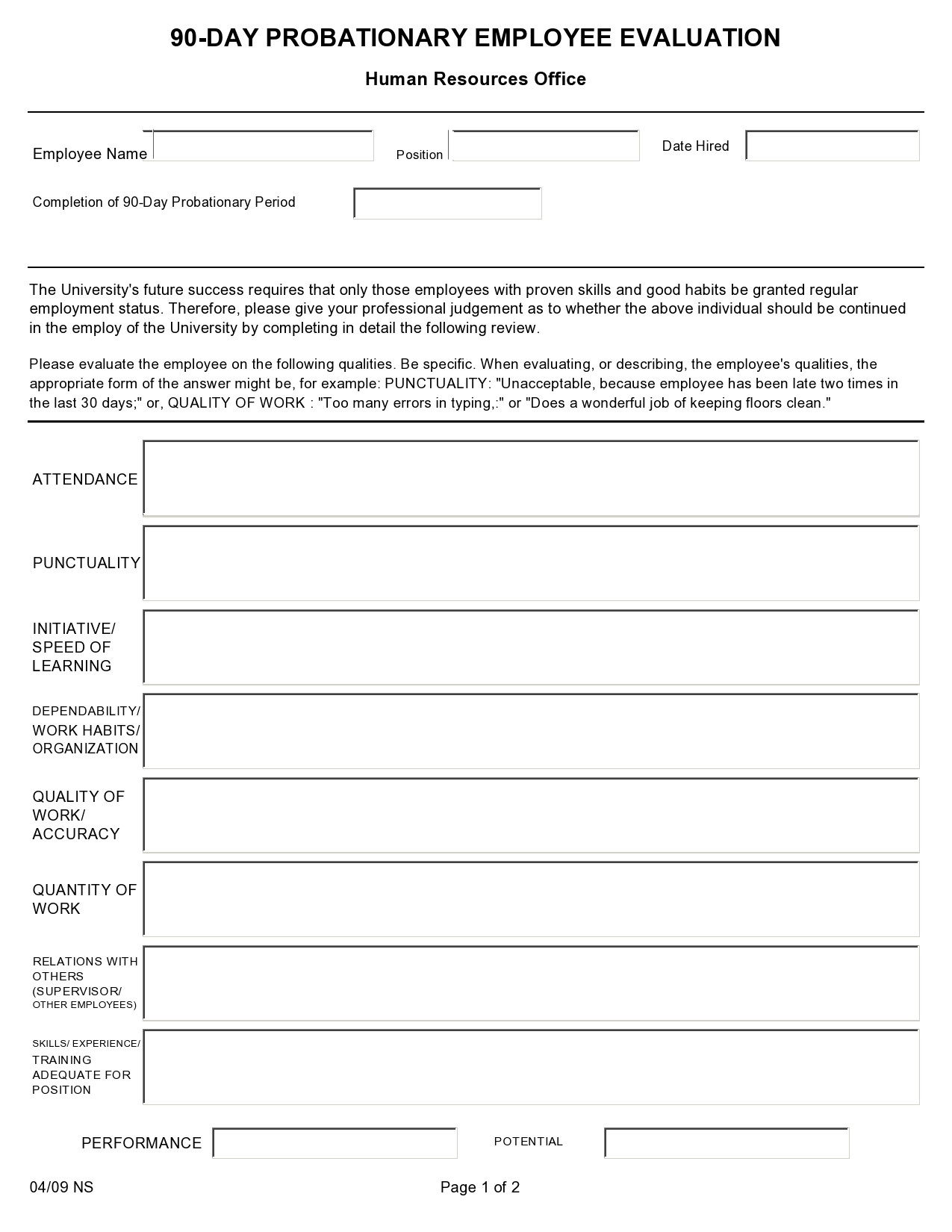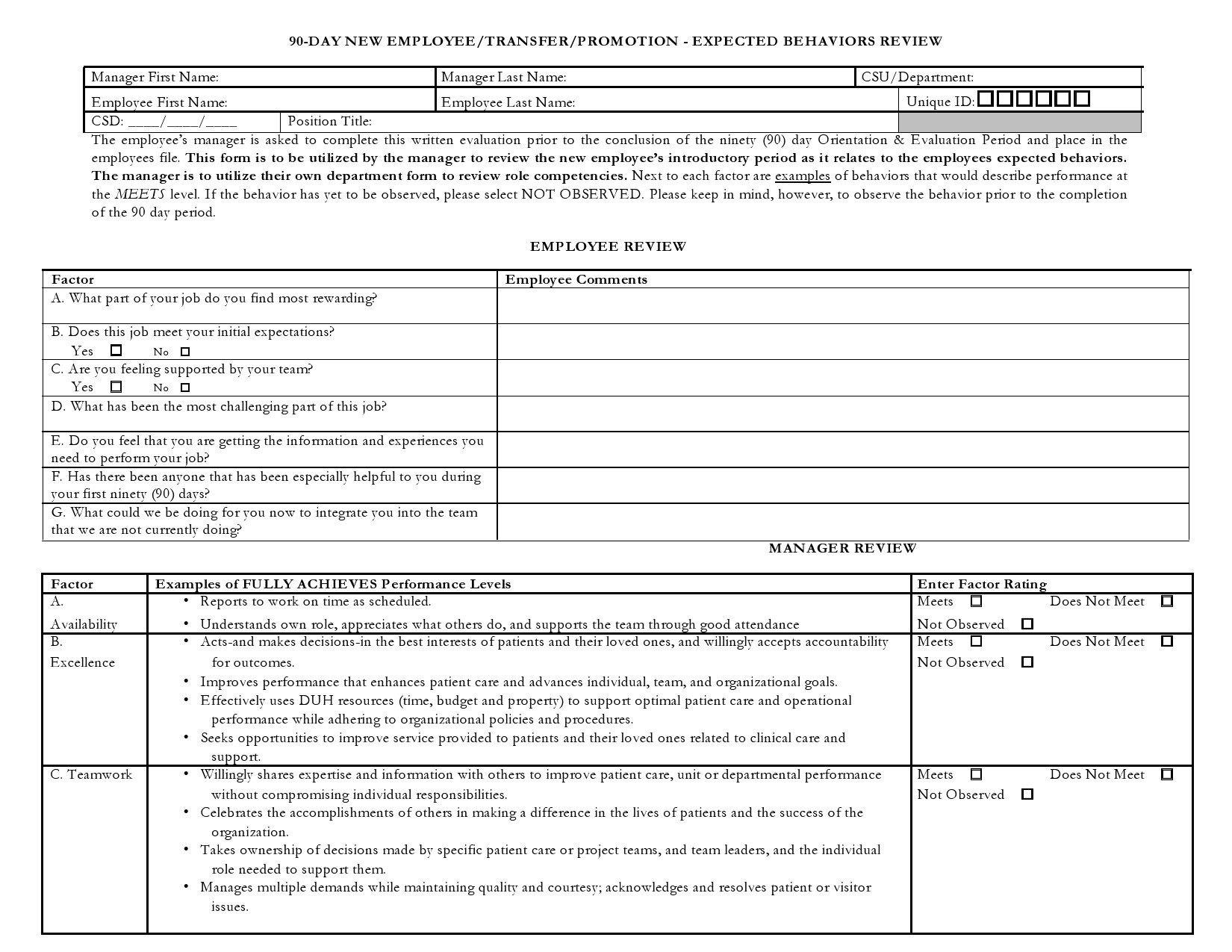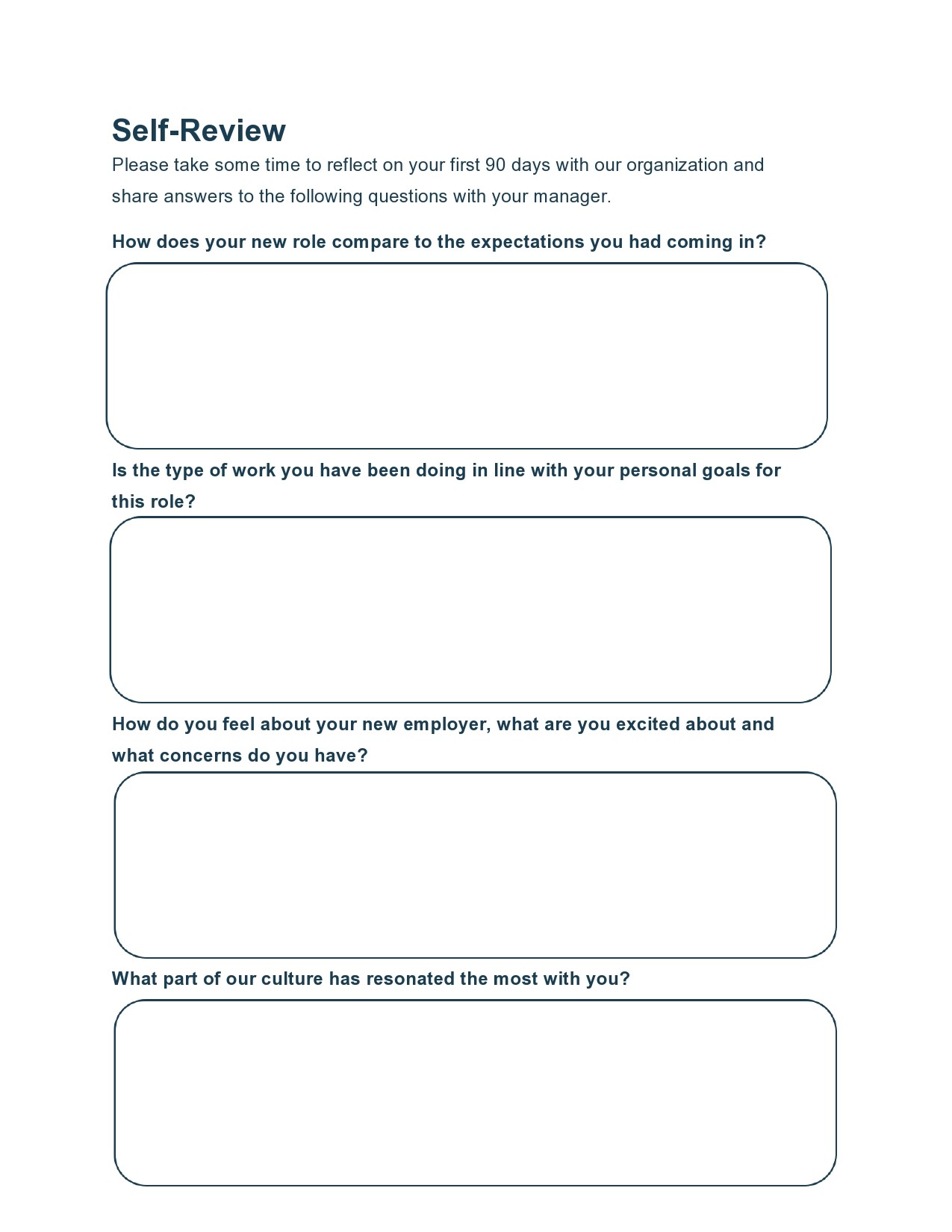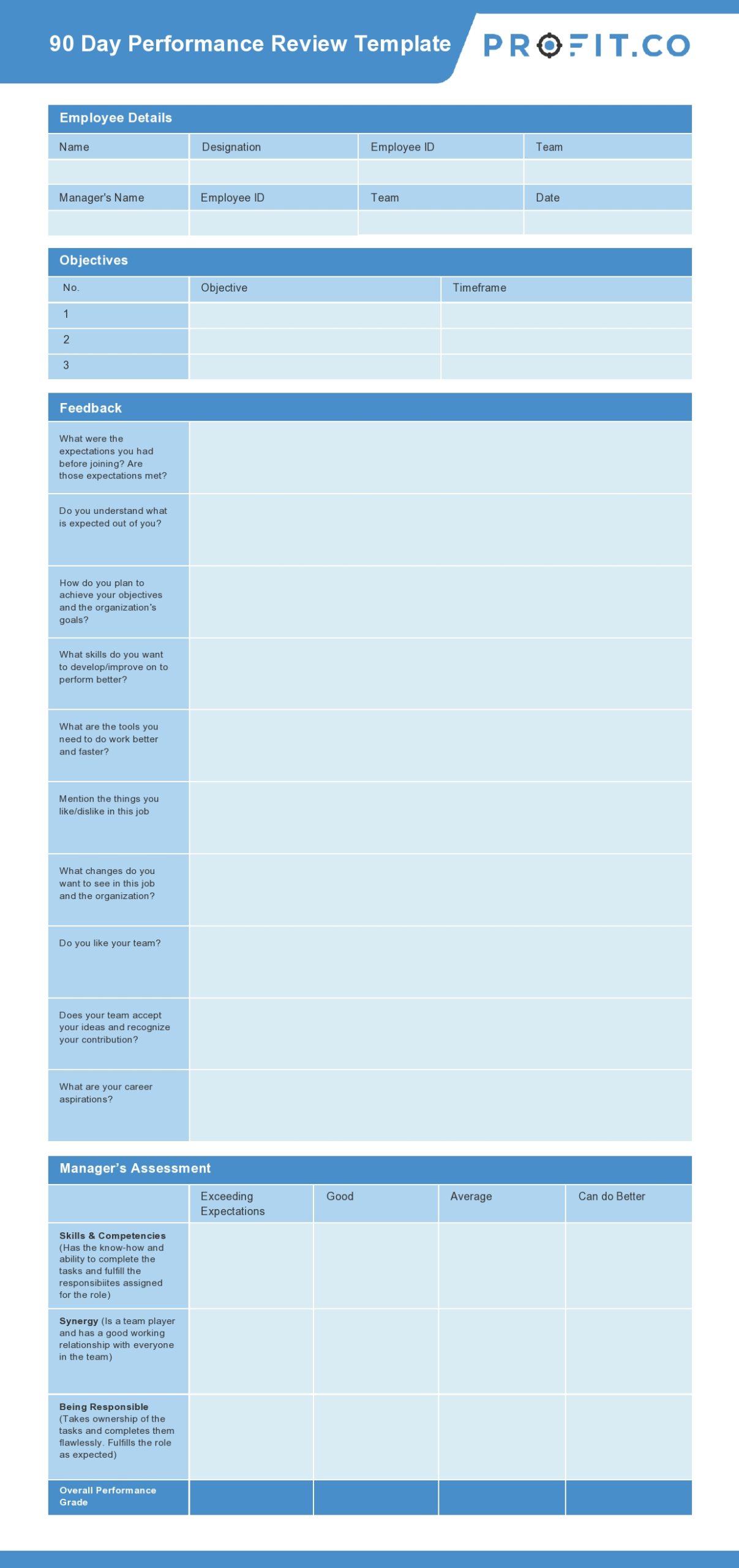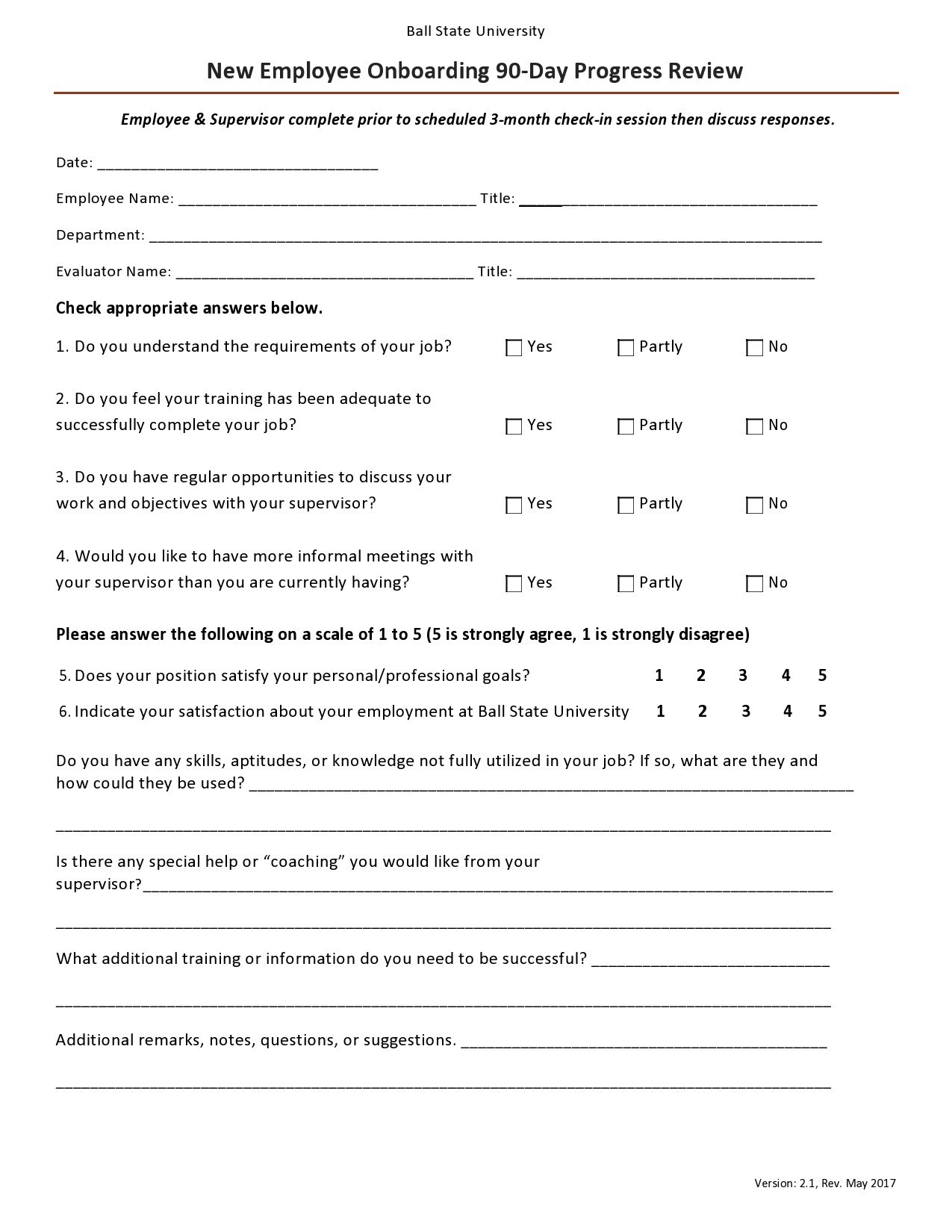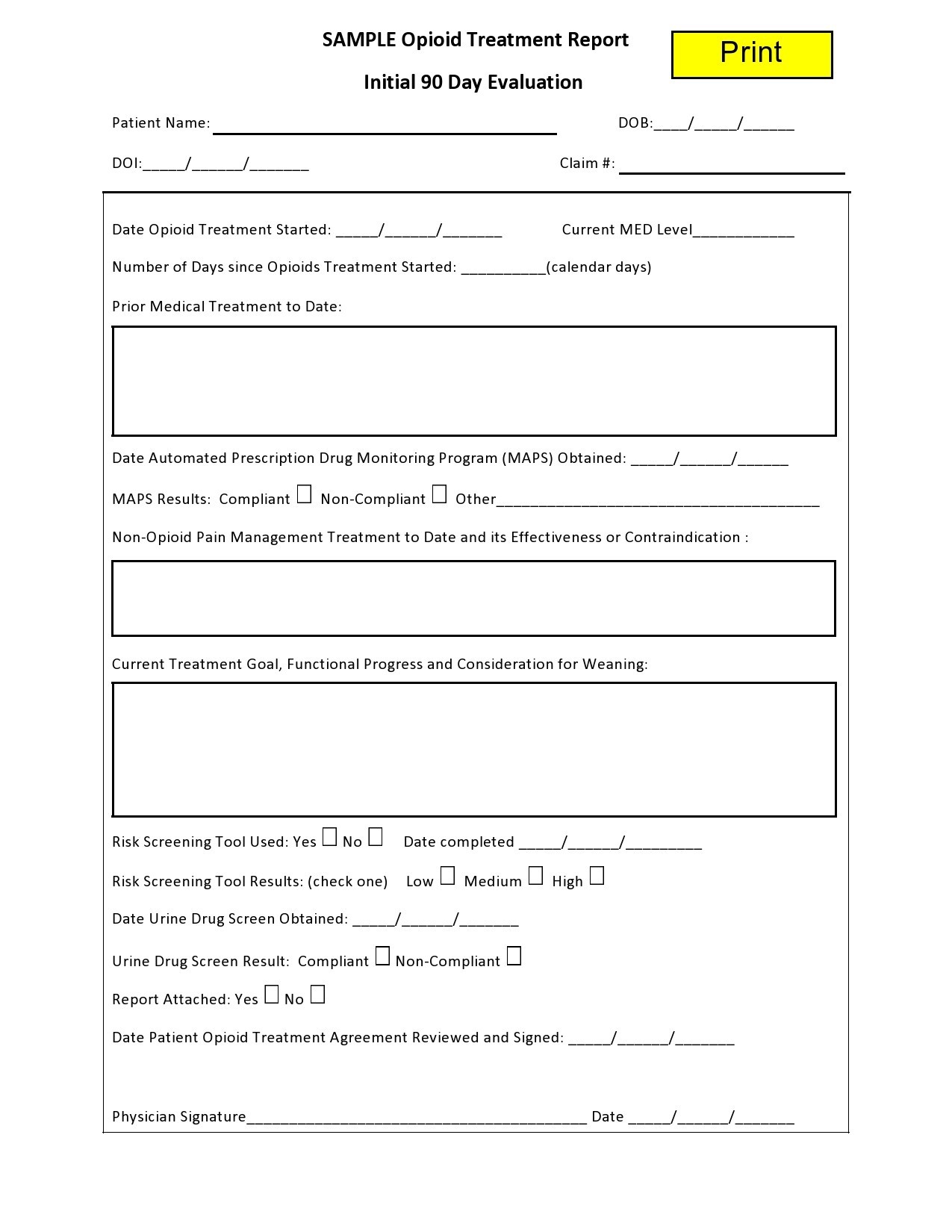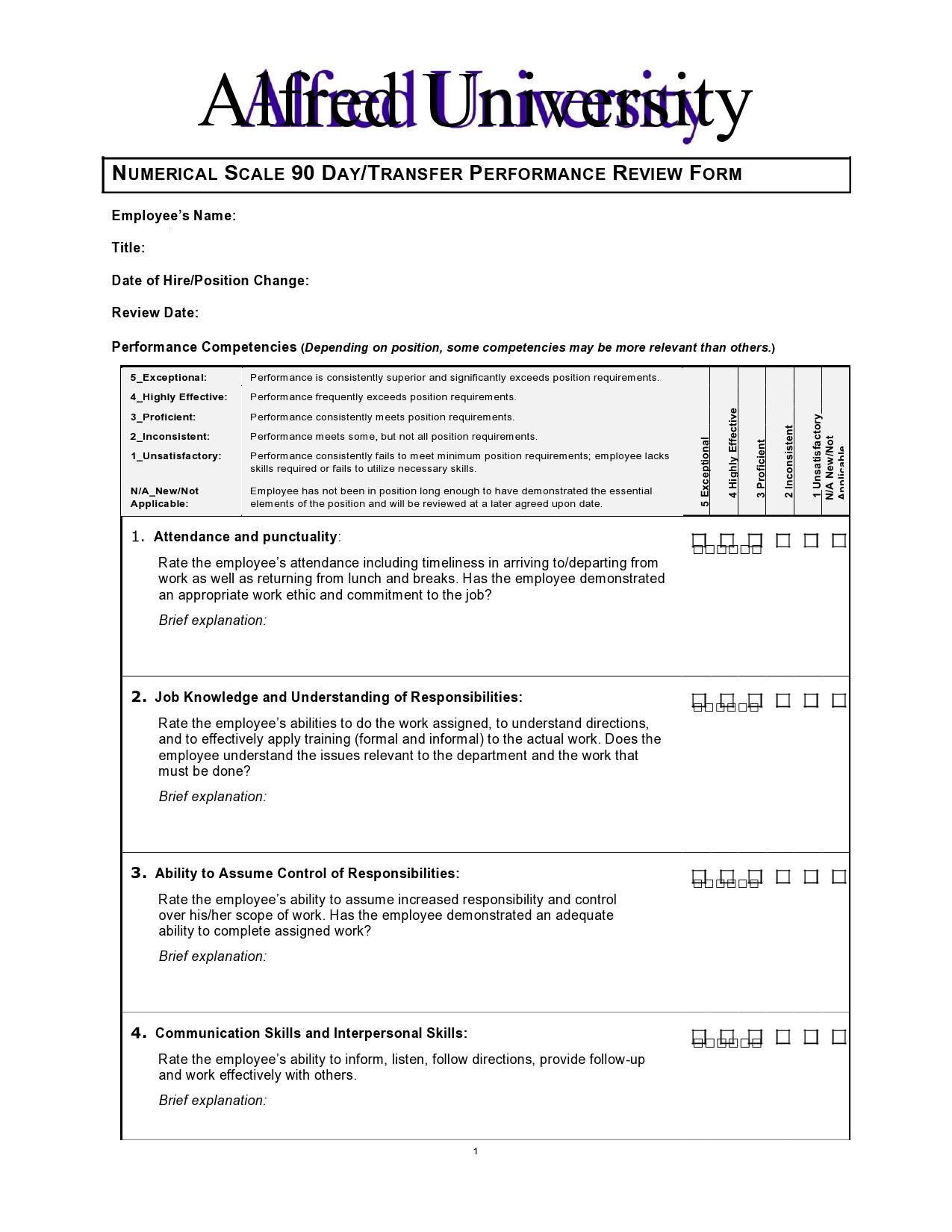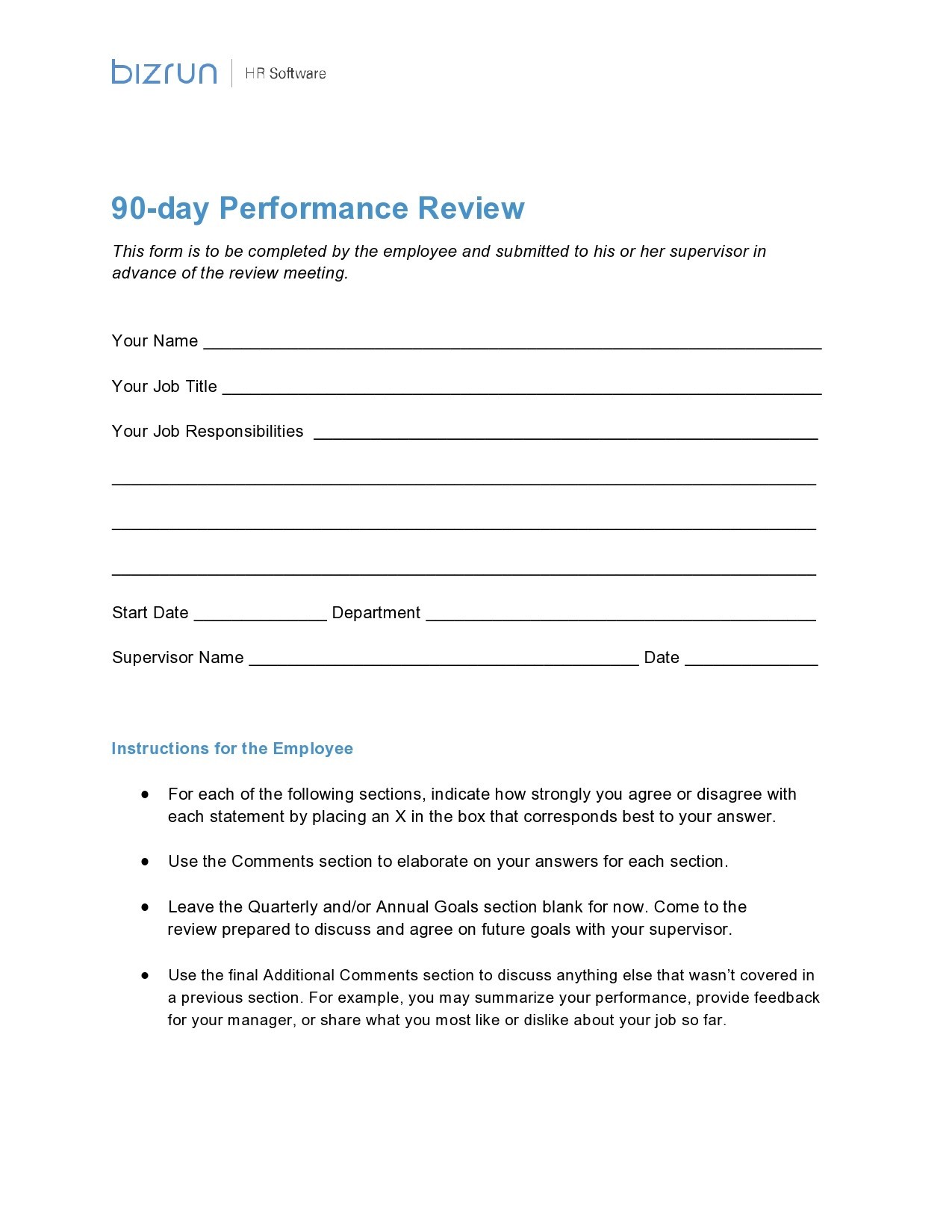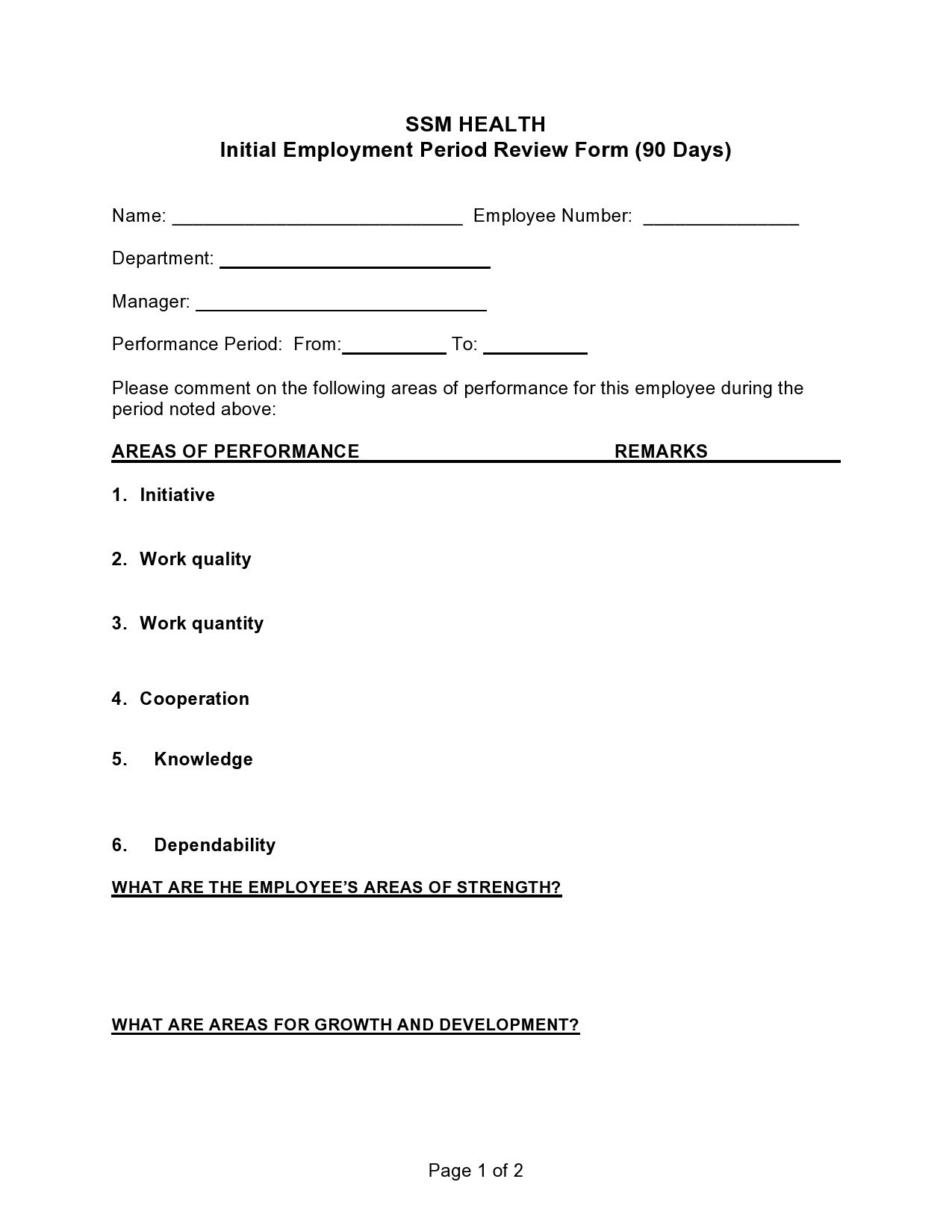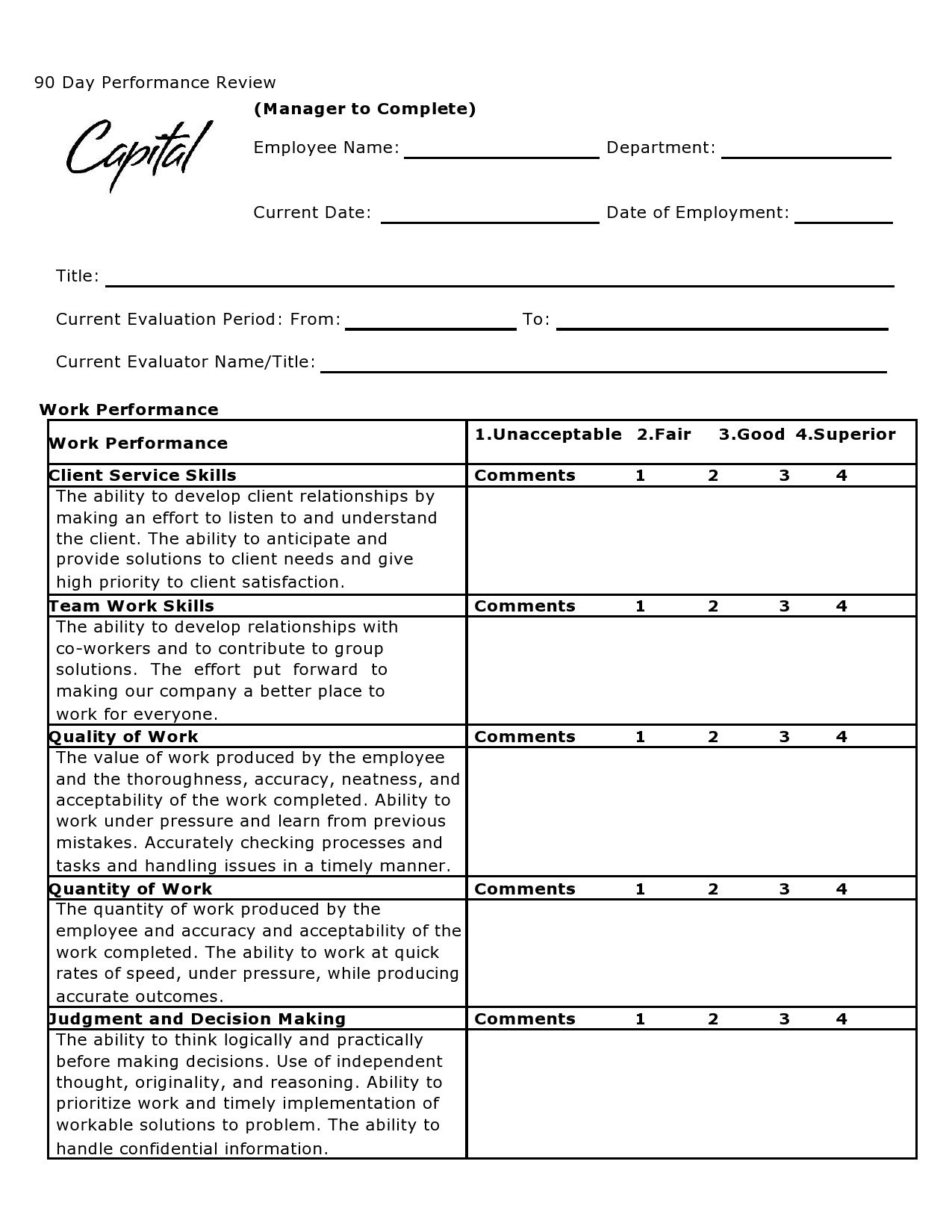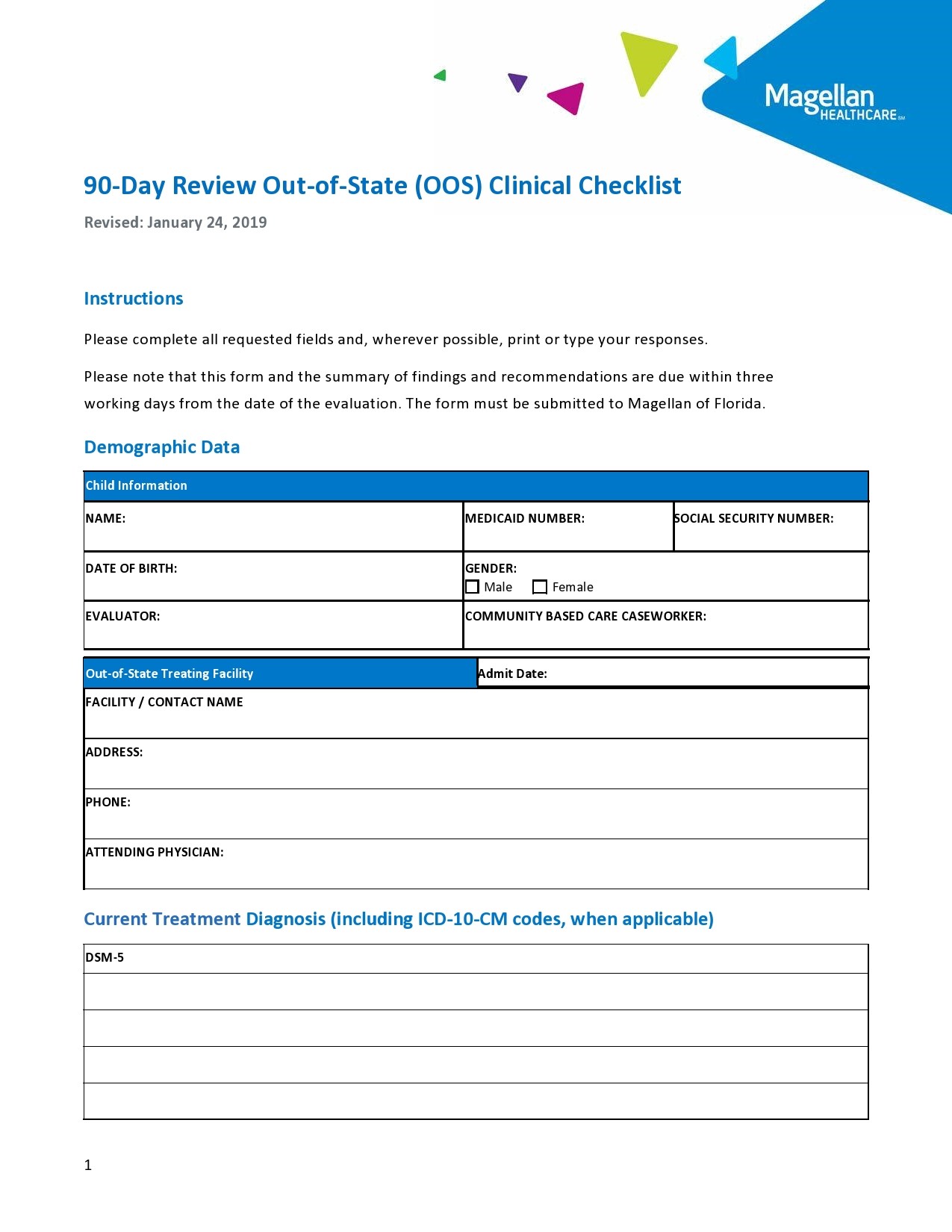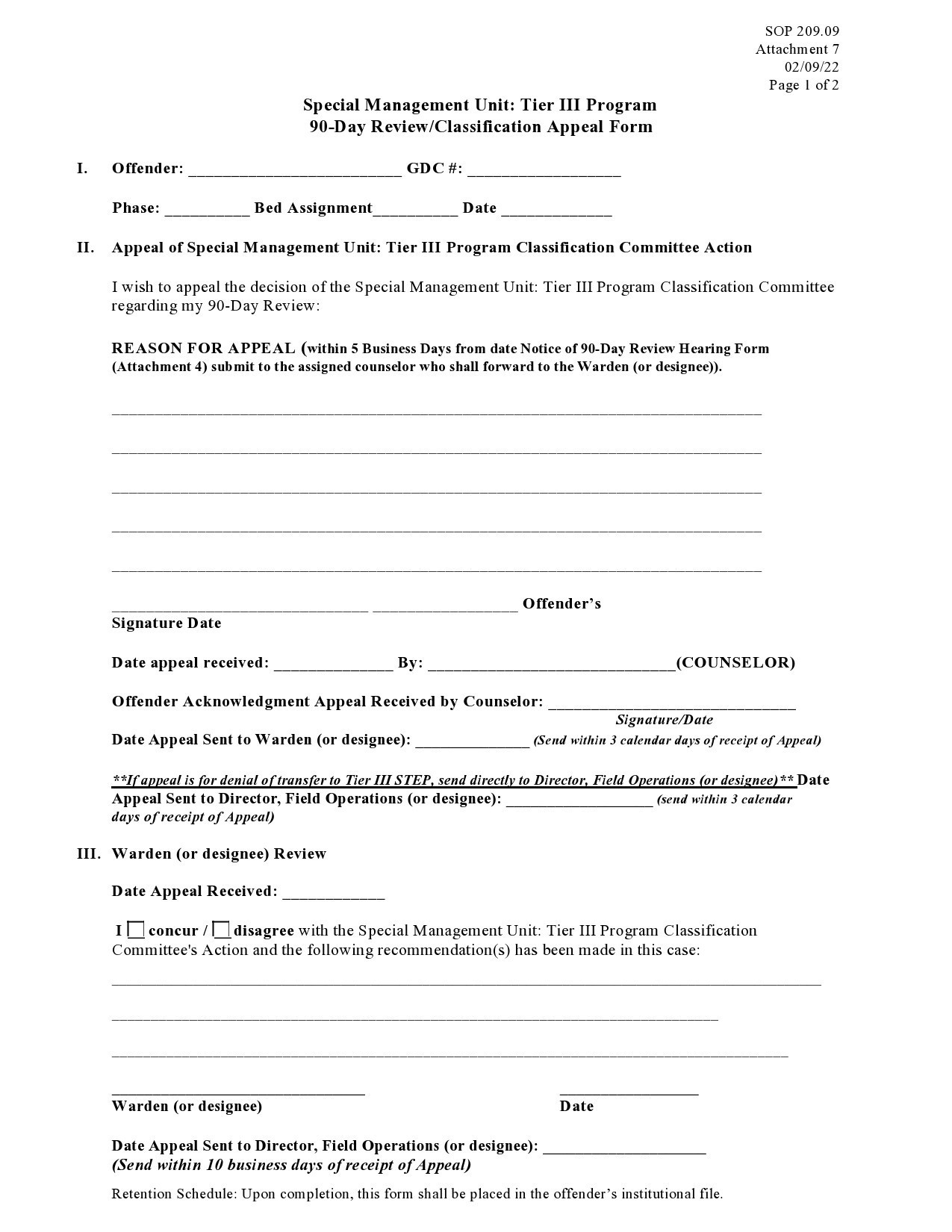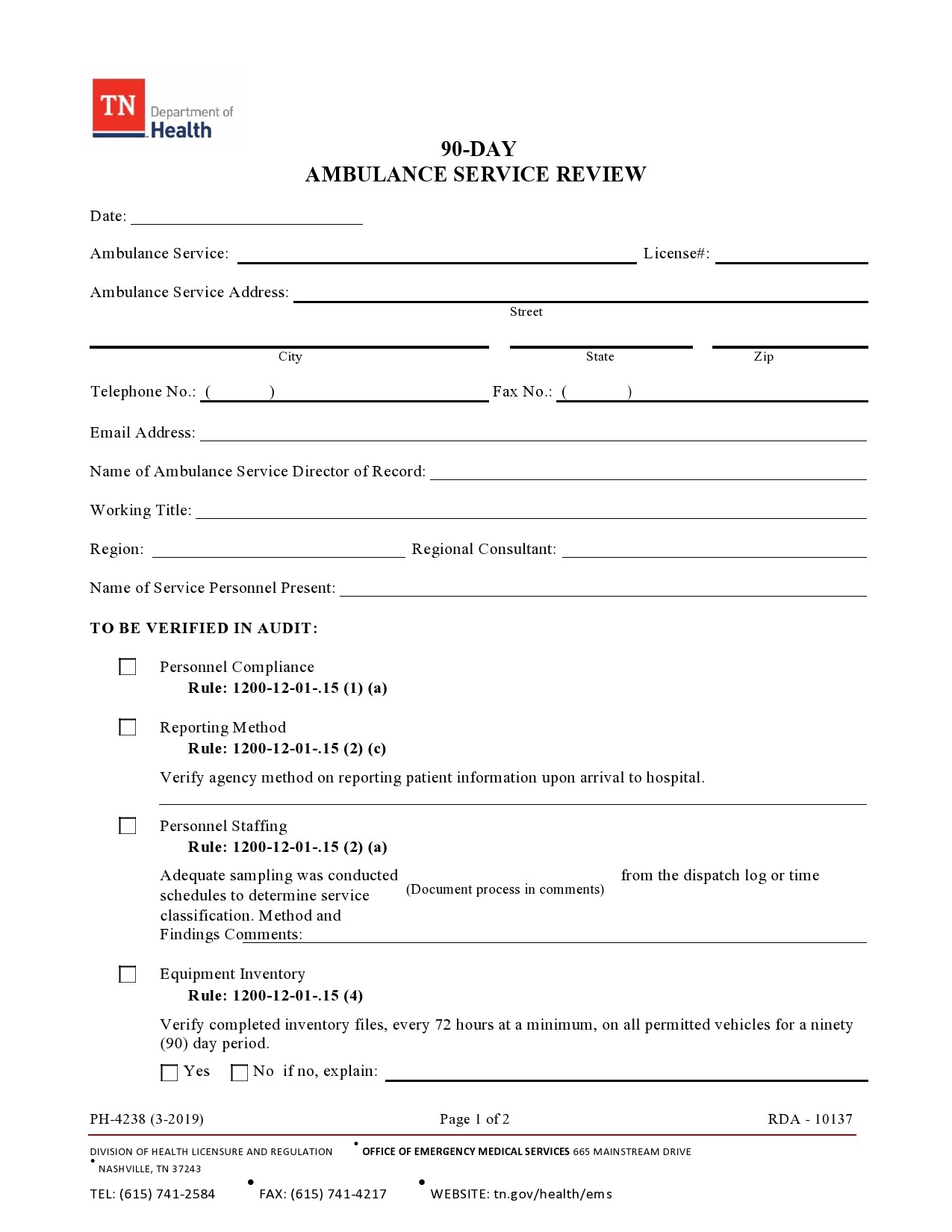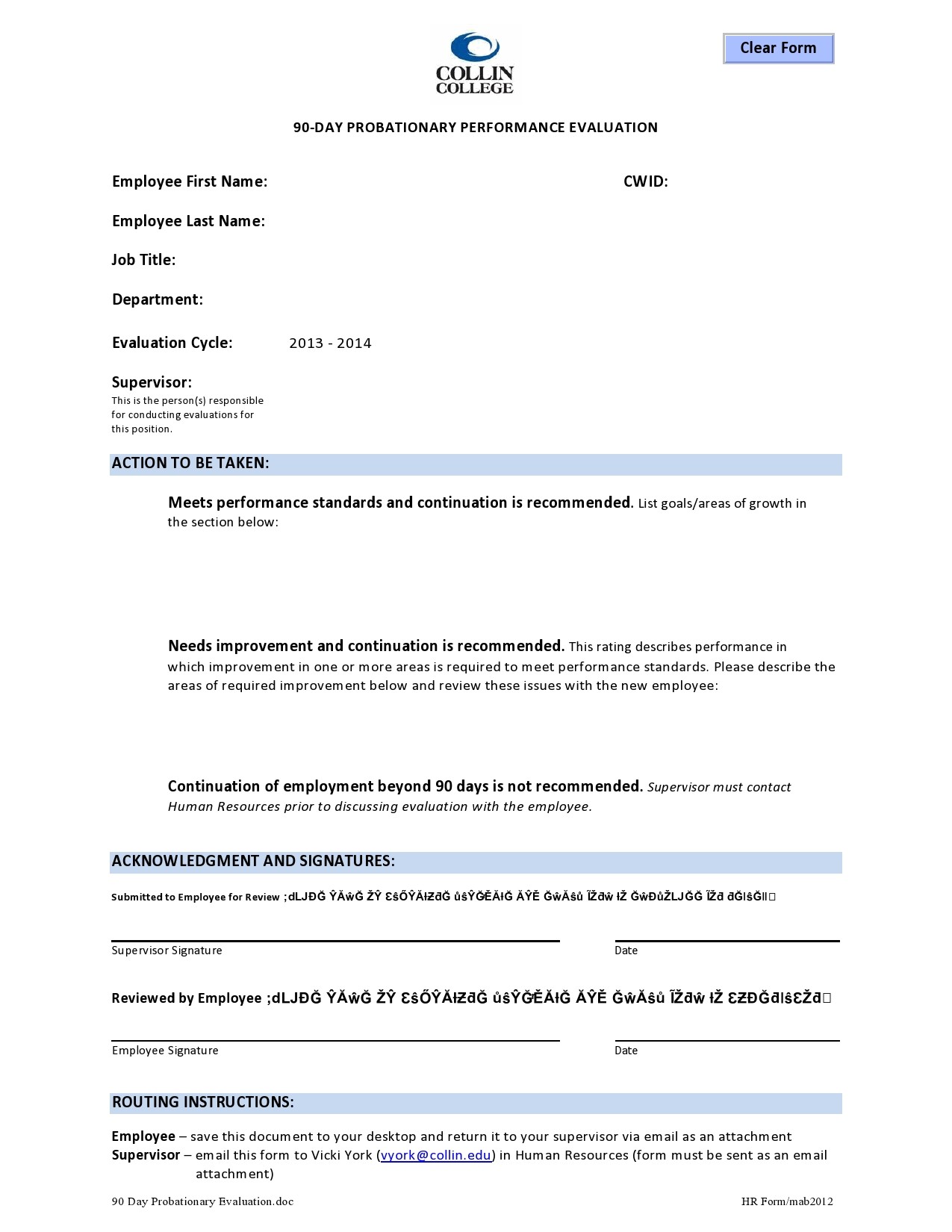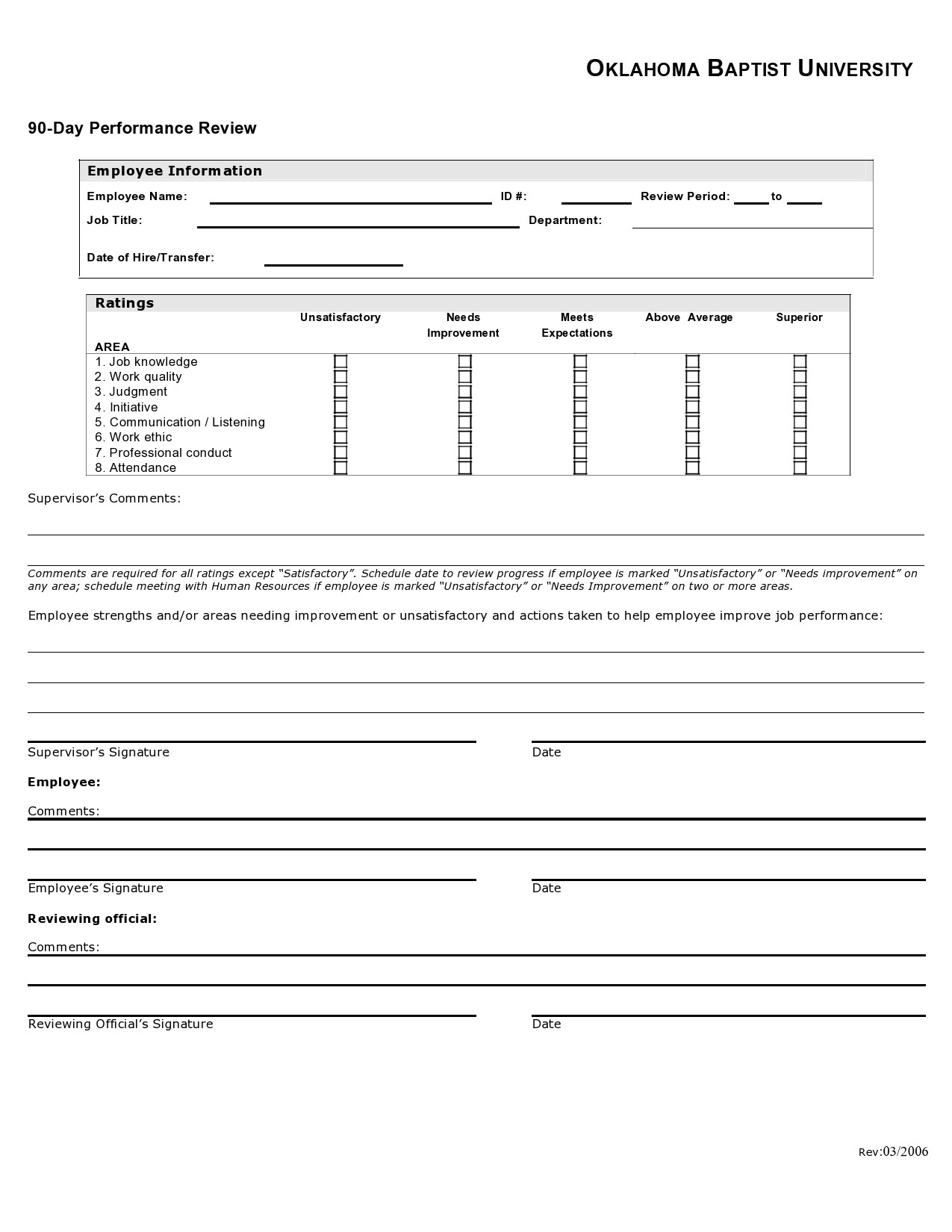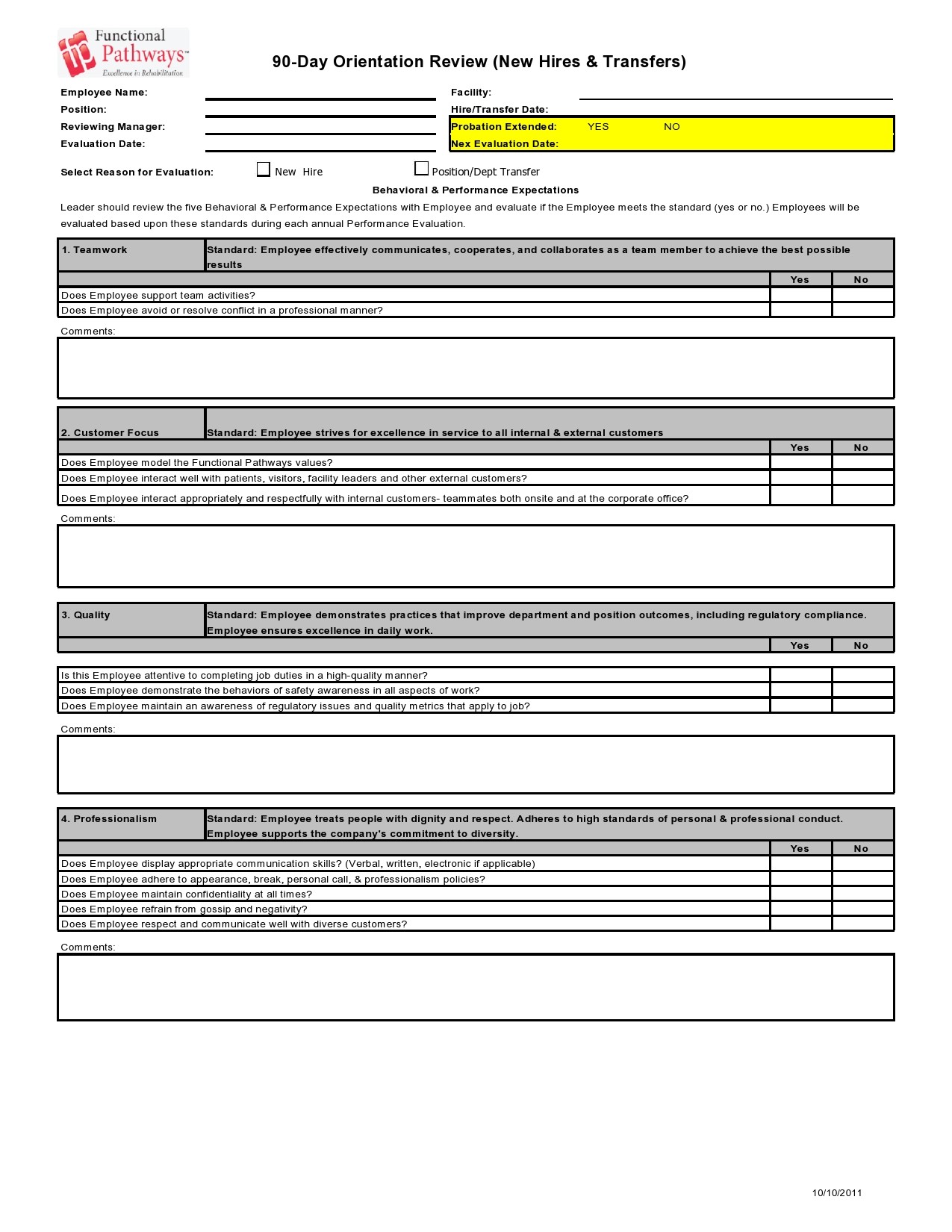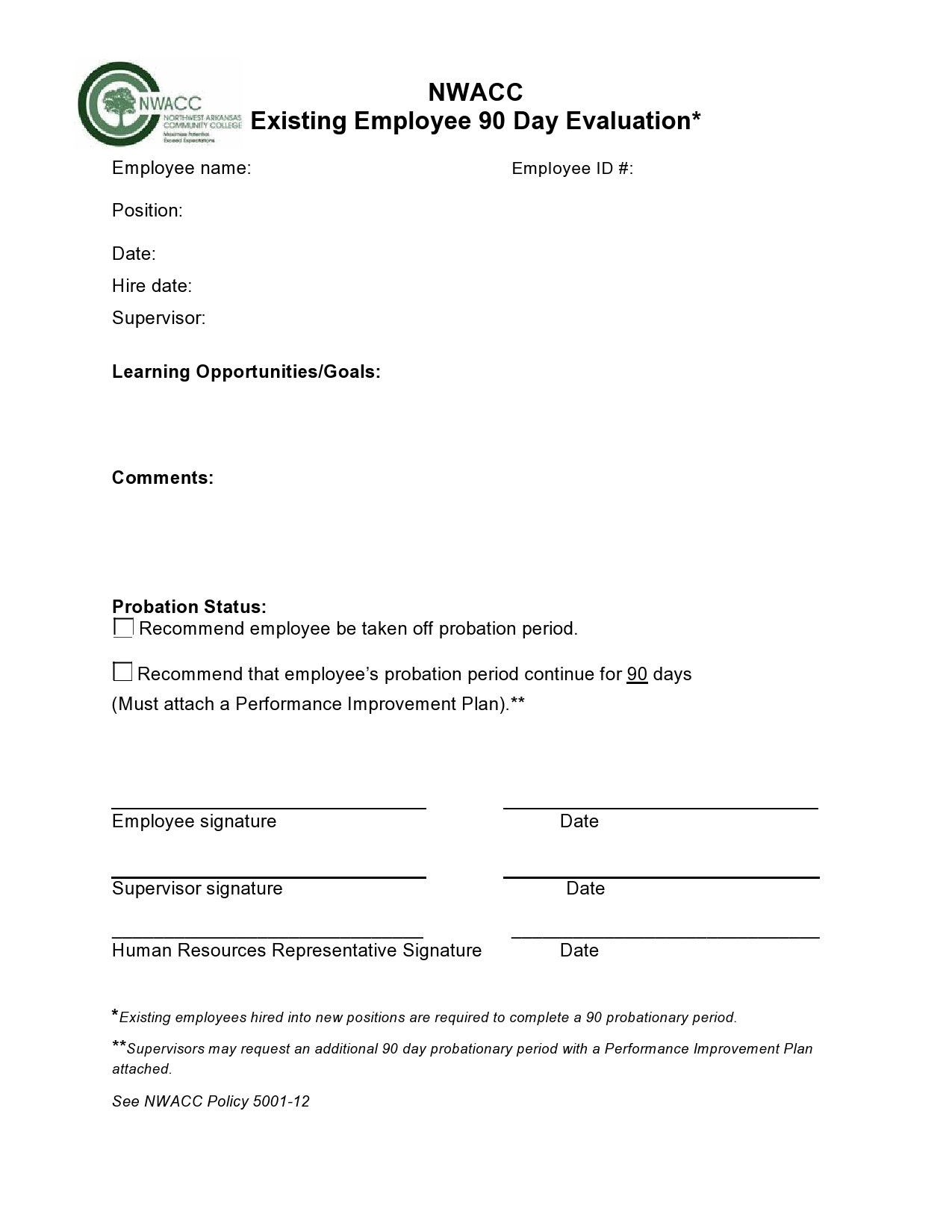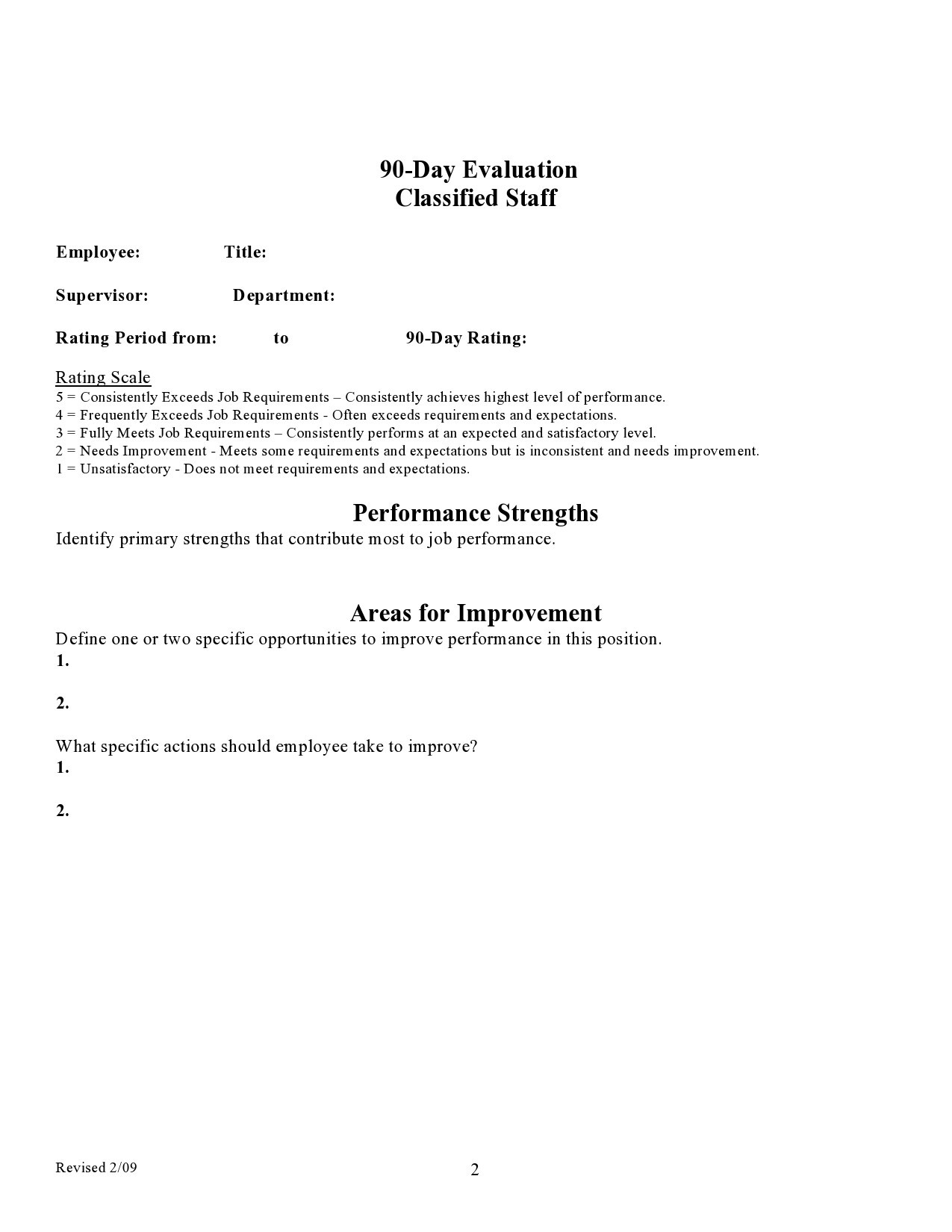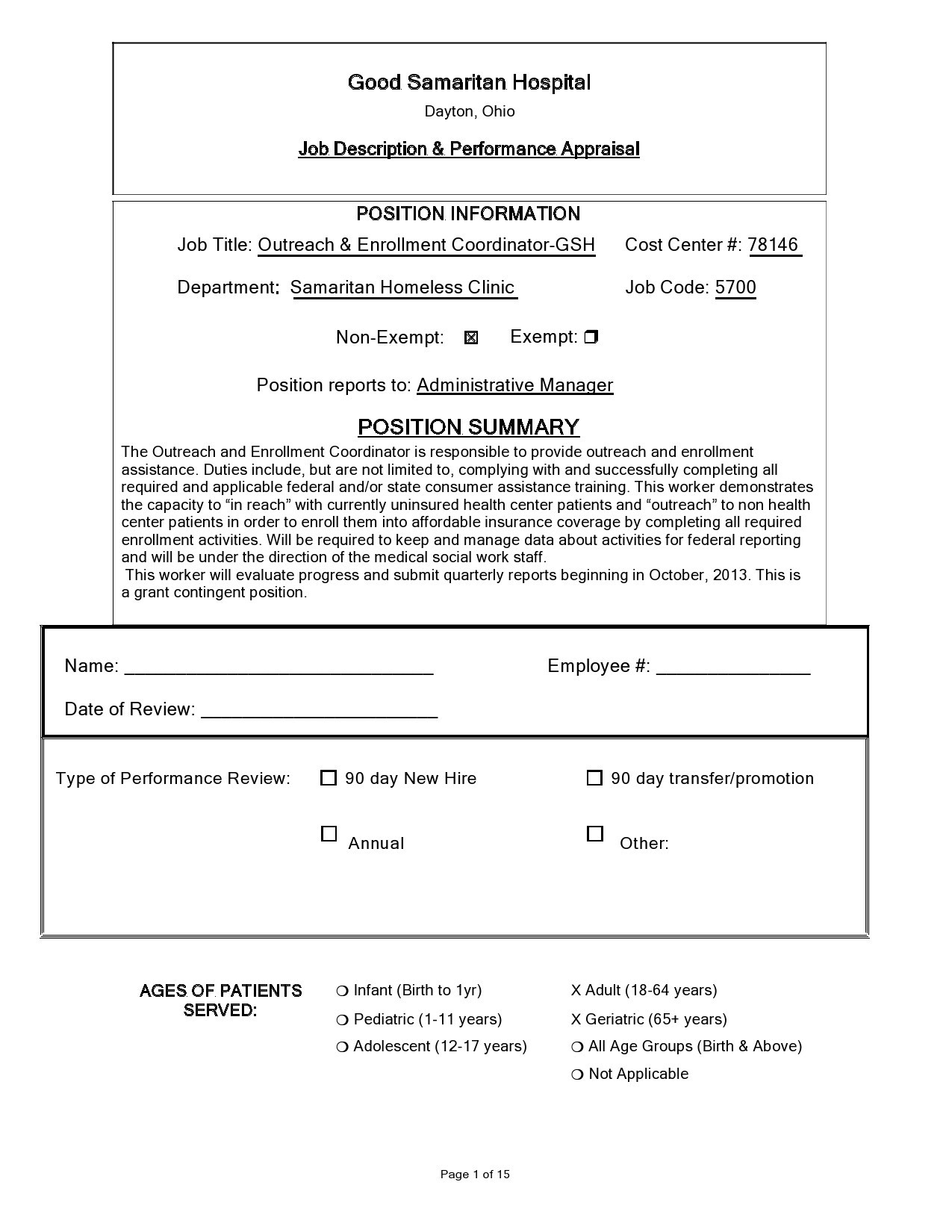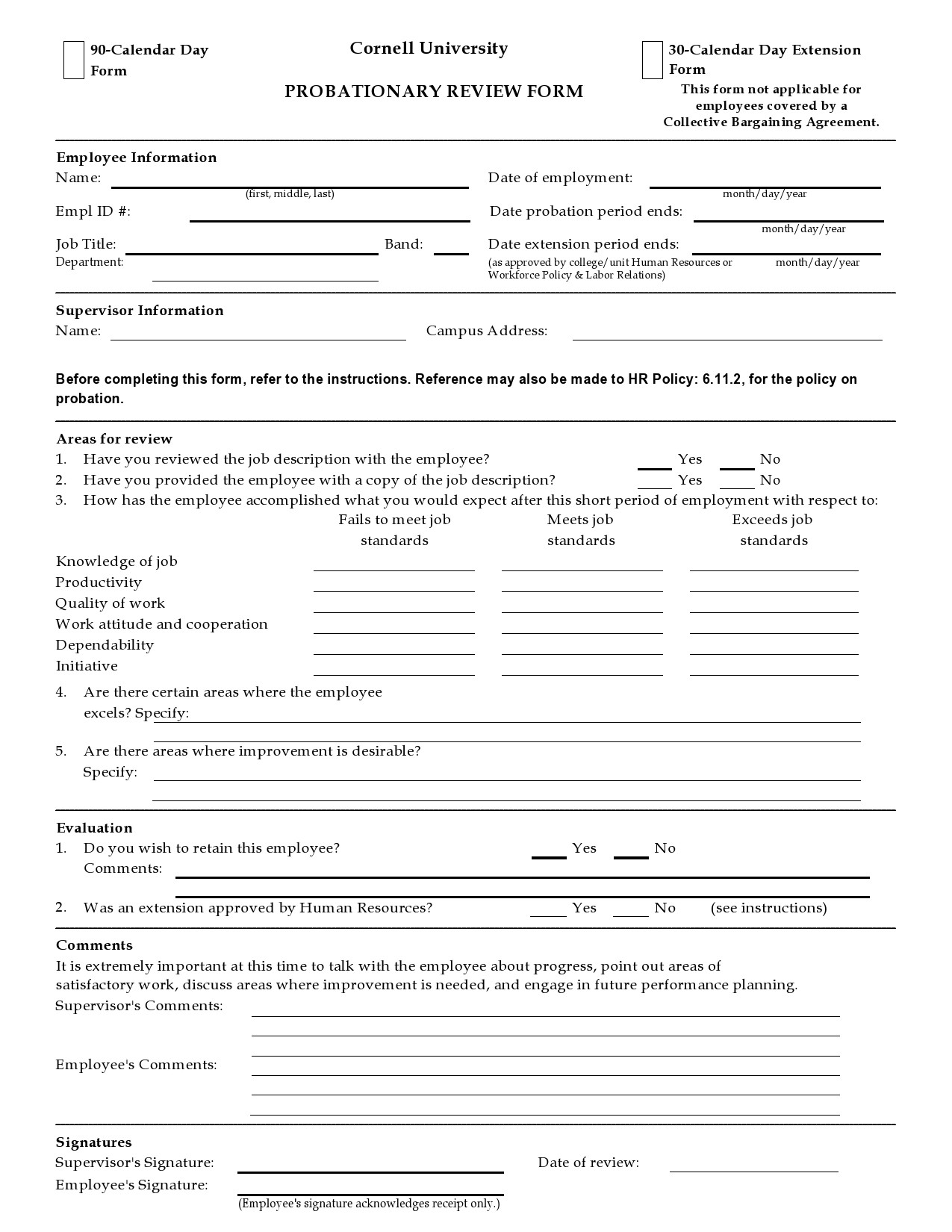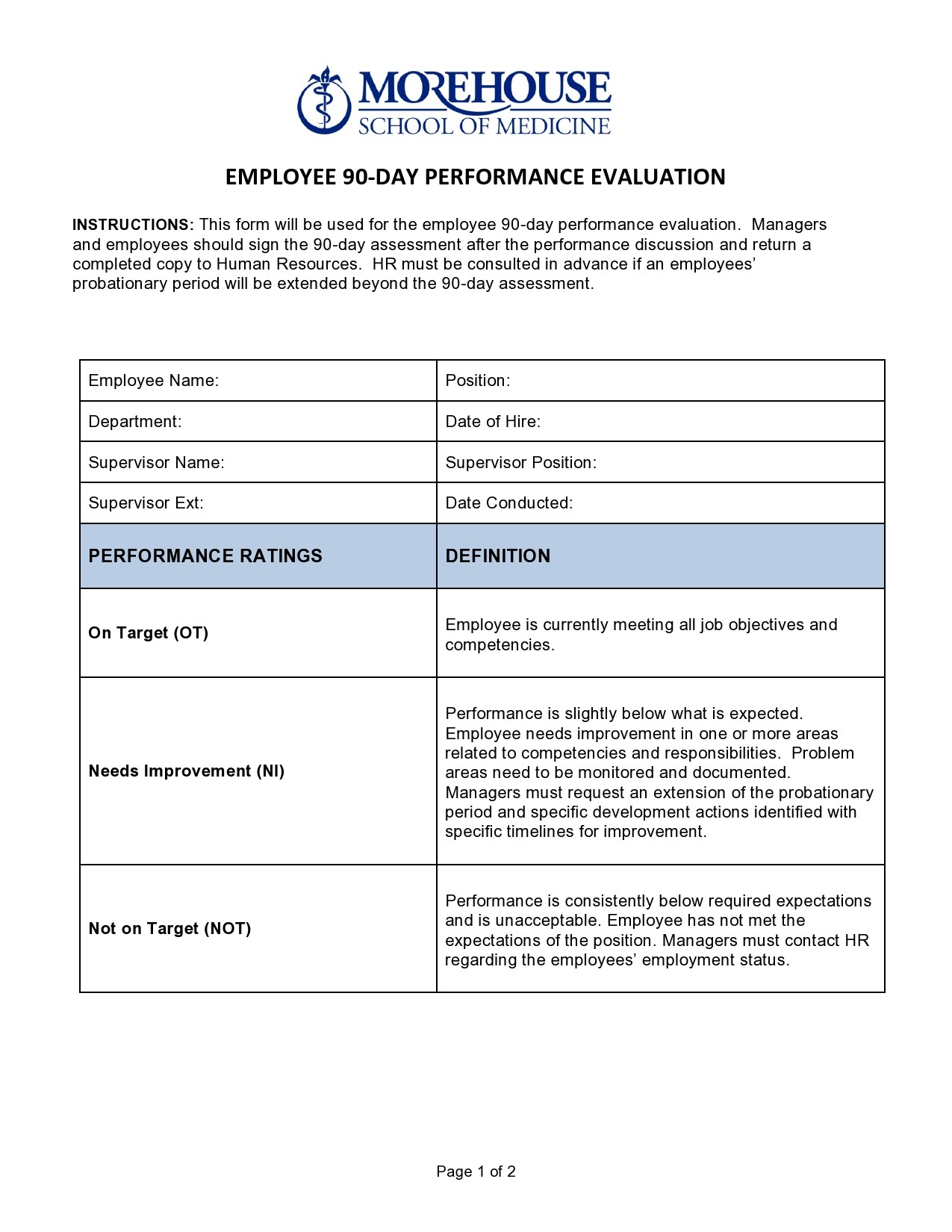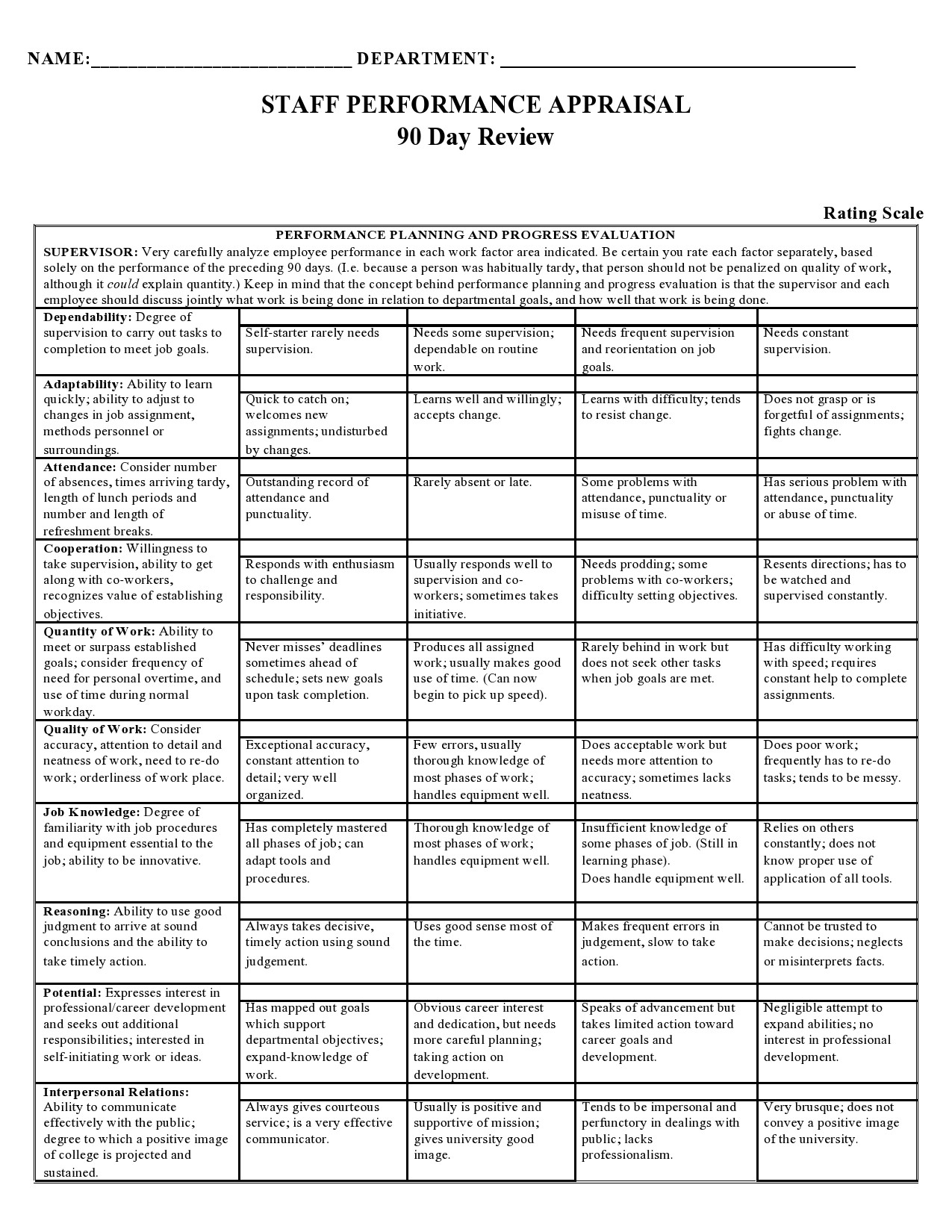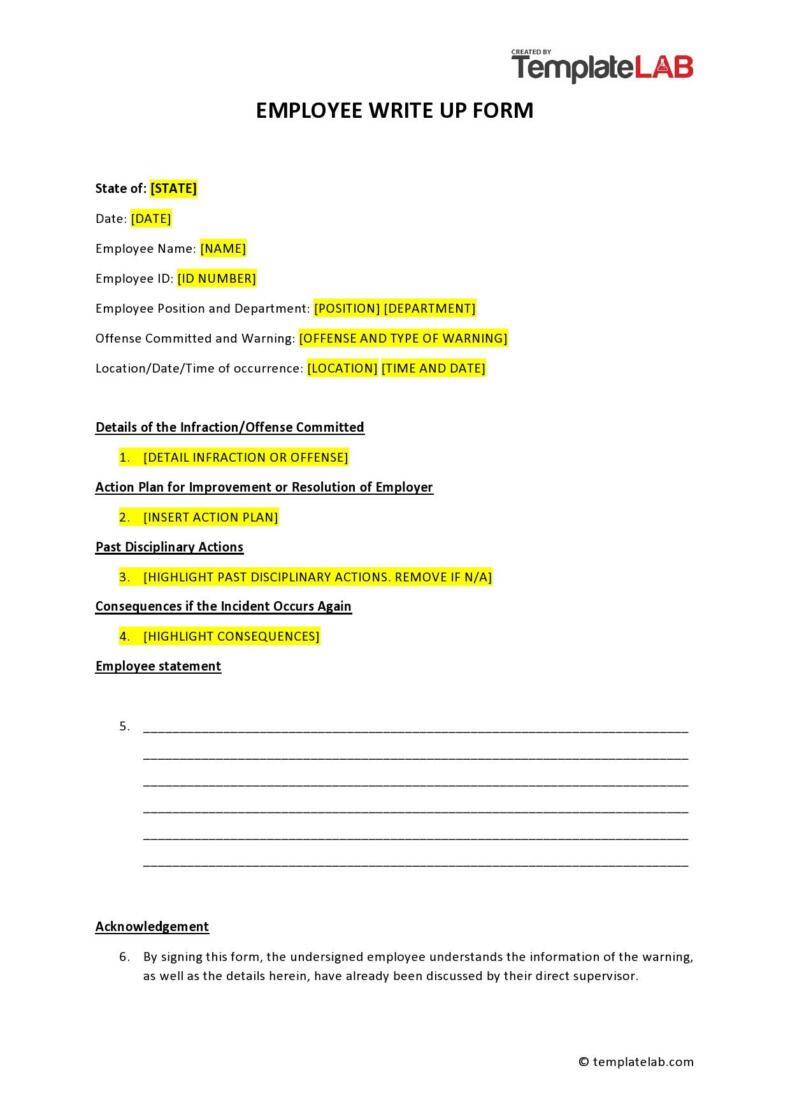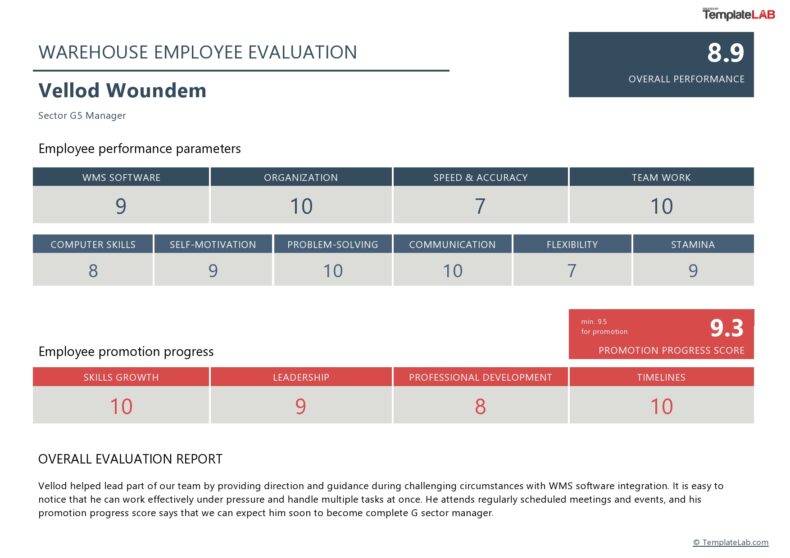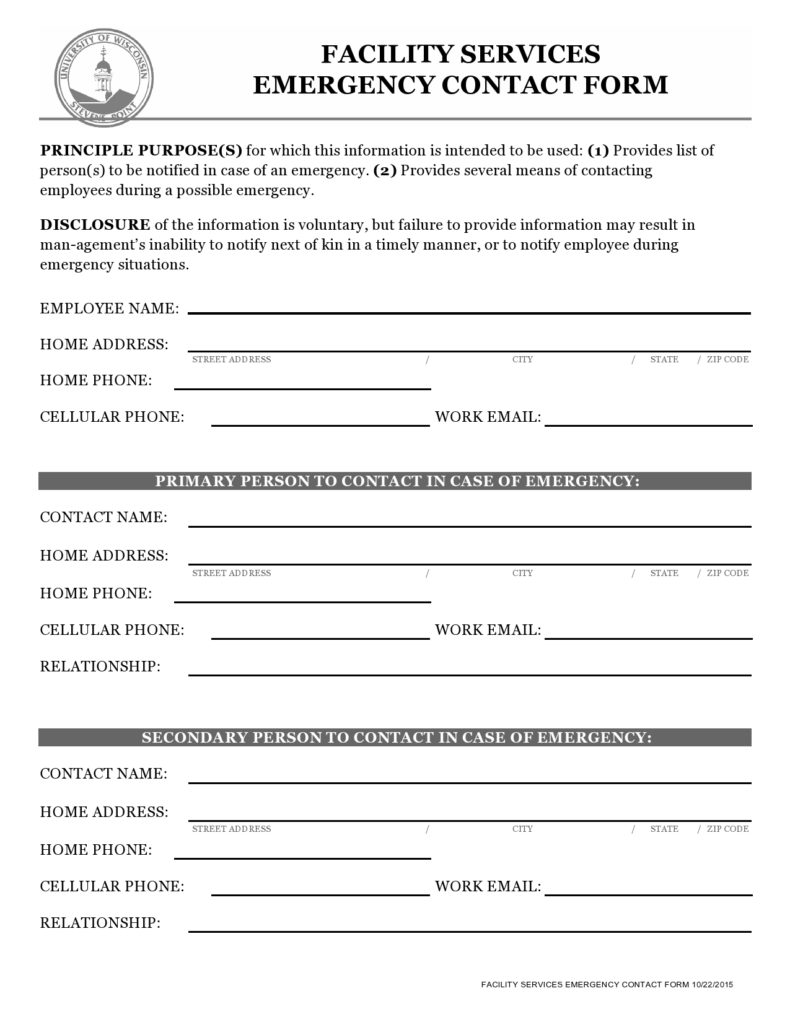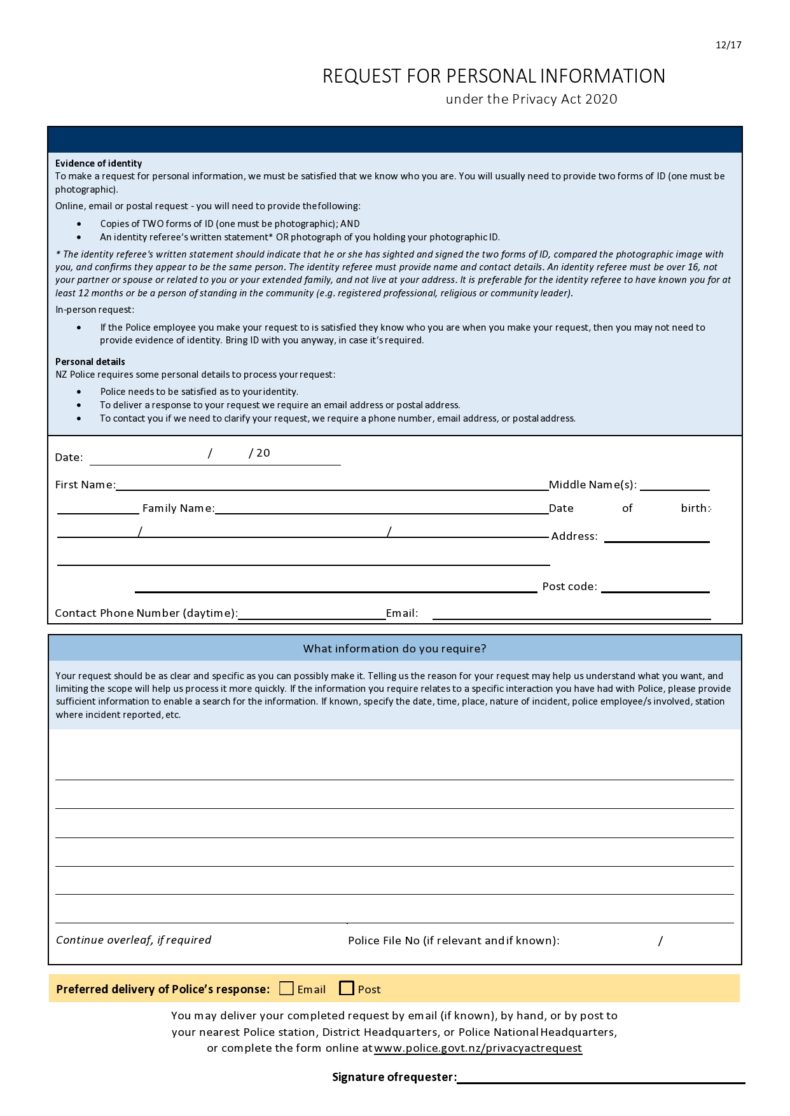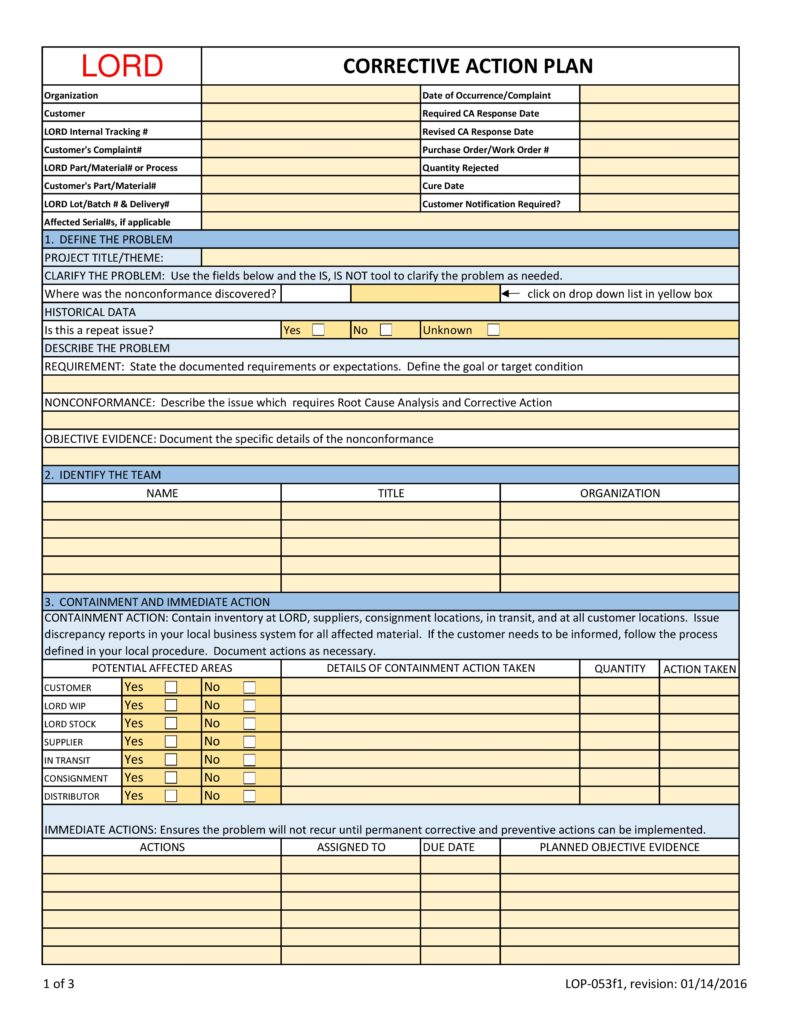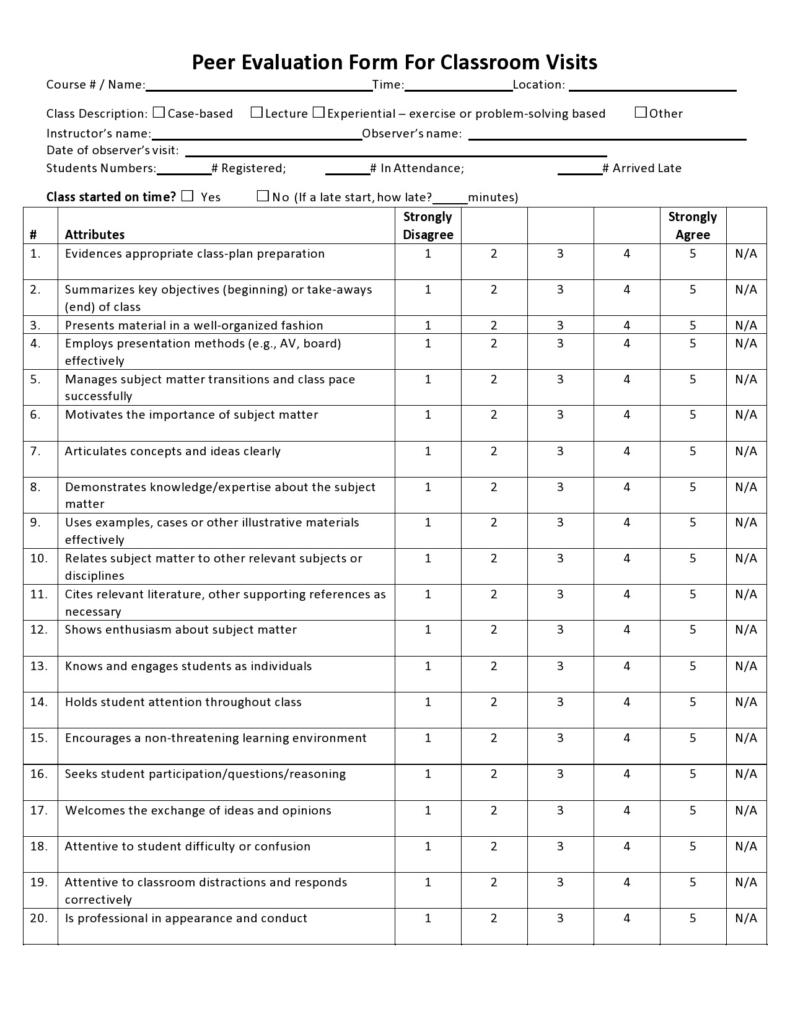It is traditional for new employees to be given 90-day probation. The new employee spends this time getting acquainted with the new work environment. They use the same time to decide if the job is what they expected. The employer uses this time to observe the employee at work. From the observations, they can tell if the new worker has the right skills for the job. Once the 90 days are over, the HR manager uses the 90 day evaluation form to help them make the final decision.
Table of Contents
- 1 90 Day Review Templates
- 2 What is a 90-day evaluation?
- 3 90 Day Evaluation Forms
- 4 Why is a 90-day review important?
- 5 Benefits the new employee gets from the 90-day evaluation meeting
- 6 90 Day Review Forms
- 7 What should a 90-day review include?
- 8 90 Day Review Samples
- 9 How do you ask for a 90-day review?
- 10 How do you write a 3-month performance review?
90 Day Review Templates
What is a 90-day evaluation?
After the recruitment process, the new employee is given 90 days to learn the job and decide if they still want to work with the company. The employer also observes the employee determine if their experience and soft skills apply to their new position.
The 90-day evaluation is done once the probation is over. It is a performance-based evaluation that reviews how the worker has performed within the last three months. It is also a time for the worker to review the work conditions in the new company and decide if they want to keep their new job or quit.
Mostly, the meeting is held between the new employee and their direct manager. If the company is not big, the HR manager can arrange the meeting and conduct the review. If the new employee is okay with the work environment and the manager is okay with them, they can sign the letter for permanent hire.
90 Day Evaluation Forms
Why is a 90-day review important?
A 90-day review is important due to the following reasons.
- It is a time to review the overall performance: This is the time when the manager uses the 90 day evaluation form to determine the overall performance of the new worker. They use any useful metrics or information that tests how the new worker performed in the last 90 days.
- It is a time to review employee productivity: The new employee might not be expected to attain a high level of productivity since they are still learning. However, the 90 days can tell a lot about how likely the employee will become productive.
- The new employee learning pace: Workers take different times to adjust and learn the rules of a new work environment. The 90-day review helps the manager measure if the new employee has adjusted fully to the new work environment.
- Business culture: The new employee can share at this time how they feel about the business culture. They can share how they feel they are fitting in.
- Professional and career development goals: The manager helps the new worker to set goals to guide them for the rest of the year. They discuss with them if there is a need to train and the training opportunities available.
- Future: If the employee is ready to continue working with the company, they may receive additional tasks if they have proved productive.
Benefits the new employee gets from the 90-day evaluation meeting
The new employee will have an opportunity to share their experiences verbally and will also answer questions in the 90-day evaluation form. They will gain different levels of benefits.
- They can share their onboarding experience: The company managers often look for opportunities to improve services, such as their hiring processes. This is the chance for the new employee to share their onboarding experience. It is important to be specific and share both the good and bad experiences. The information will be useful to the management.
- The employee receives feedback: It is an excellent opportunity to receive feedback from the manager. The feedback touches on performance and productivity. It is also a good time to ask the manager about their expectations moving forward. It reflects positively on the new worker to show they are ready to move forward.
- It is a time to seek guidance: The employee might have some work-related concerns. They can use this time to raise them and seek guidance from the manager. The concerns might touch on work culture, expectations, productivity, or clarification of some issues.
90 Day Review Forms
What should a 90-day review include?
A 90-day evaluation marks the end of probation or an onboarding process. The evaluation mirrors back the last three months since the new employee joined the company. The meeting should be two-sided, where the manager allows the new employee to share their feedback.
The manager must have ready with them the 90 day review form and the questions they will ask the new employee. It is the best time for the new employee to read some 90 day review samples to get an idea of what to expect during the meeting. The 90-day review form should include the following:
Onboarding questions
Onboarding questions address the onboarding process. They help the manager get ideas on what is working for the company and what areas require improvement. The manager may ask questions such as:
- How would you rate our onboarding program?
- What recommendations would you suggest to help you make it better?
- Which part of our onboarding program did you like most?
- Which one did you like least.? The ideas the employee gives for this question will help the company improve its onboarding experience.
- Is there any training you might be interested in? This question helps the manager identify the areas the new employee requires support in terms of skills.
Questions about the new employee designation
Questions about the new employee’s job roles will help the manager figure out which tasks the employee could still be struggling with. They will also know which tasks the employee is best at. This section could ask questions such as:
- Has your role in this company met your expectations? The answers the manager gets can help them figure out if they described the roles accurately.
- What issues do you like about your job?
- What issues do you dislike about your job? This question helps the manager learn what the employee prefers most. It can help the manager restructure the roles by removing or adding some.
- For the last 90 days, how would you grade your position? The question helps the manager learn about the worker’s self-awareness.
- What’s your feeling about working here? The answer they give will give the manager an idea if the employee is ready to continue working with the company. They might not directly say it but their words will tell if they are already looking somewhere else.
Questions about the work team
These questions dig deeper into the work team dynamics. The employee shares how they feel about working with their teammates. The questions help measure how well the employee is fitting into the new work environment. The team could also be hostile to the employee refusing to cooperate. The manager can have in the 90 day review form questions such as:
- Within your team, who has been most resourceful to you? This is another way to identify the most valuable workers. They can be recruited as mentors.
- Who do you approach most anytime you need to ask something?
- Are you comfortable speaking to them? The question helps the manager to assess dynamism at work.
- Have you had any challenges working with your supervisors, workmates, or customers?
- What help can we provide? This is the best chance for the employee to open up and share their work experiences. It is also the best chance for the manager to bring up any issues they might have noticed with the employee.
- According to you, are your work ideas valued by your workmates? One of the reasons an employee may feel they want to quit is if their ideas are always devalued. If this is the situation, the manager can take this chance to correct it.
Questions about short-term and long-term goals
These questions help the manager get an idea of what the employee expects both in the short-term and long-term goals.
90 Day Review Samples
How do you ask for a 90-day review?
Sometimes the manager might not ask for a 90-day review. The employee can take the step to ask their manager for a review. It can help the manager receive important feedback that can help them improve performance.
It will be a good time to receive insights from the manager concerning work expectations. Check some 90 day review examples to know what happens during the review. It will be important to know how to ask for a 90-day review. Here are the steps to follow.
- Timing is important. The manager could be busy, which can be the reason they are not asking for a review. The best time to approach them is when they are relaxing during their lunchtime. Another good time is when they are catching up on the news in the morning before the official work time begins. If they come to your desk on an official work routine, use the chance to ask for a review.
- Make a formal request. You can get ideas from the 90 day review examples on how to make a formal request. If you make a verbal request, the manager may accept it but they can easily forget due to work engagements. It is best to make a written request that they can file and act as a reminder.
- Highlight the benefits. The reason you are asking for a 90-day review is that you want to benefit from it. It is important to highlight these benefits. The manager will value your request and honor it. Acquaint yourself with the question by reading 90-day review examples.
- Get ready with your goals. Since you are the one who requested the 90-day review, it is best to get ready with your questions or goals. Have an agenda for the review. Make a list of questions you would like to ask the manager. Mark the areas you would love to improve on. The manager will come with their set of questions but make sure you have yours too.
- Create a feedback strategy. Feedback helps an employee improve work performance. It can help them improve on their efforts and mindfulness of their role. Sometimes even old workers request for review to help them know how they are performing.
How do you write a 3-month performance review?
The main purpose of a 90-day review is feedback. The manager provides feedback to the employee and vice versa. The main focus should be to help the employee become better but not to criticize.
The feedback should be approached positively. Get the right three-month review template. You may read the 90-day review samples to help you choose the right template to use. This is how you write a three-month performance review.
- Write your goals. The 90-day review must be tagged on goals. The goals focus first on the past, then the present and future. The past focuses on how the employee has performed in the last 90 days. The present focuses on where they are at the moment. The future focuses on where they are headed or what is expected from them.
- Create the review time. Do not create a tentative 90-day review time. Instead, create a specific time. Give the employee a specific day and time. Let the meeting be in a private setting to avoid distractions from customers or employees.
- Write the performance review. Apart from the verbal feedback, prepare written feedback that the employee can take. It will help them spend time later to read the feedback and let it sink in them. In the written review, include some specific examples of how the employee has been performing.
- Prepare the 90-day review questions. To ensure the review meeting goes on smoothly, prepare the sets of questions relevant to the meeting. These are the questions that will help you get a lot of insights from the employee. The answers they give will help you know the best strategies to help them. After your set of questions is over, give the employee time to ask their set of questions.
- Prepare the follow-up strategy. It is important to do a follow-up after the review meeting. There will be issues that you highlighted that require your attention or another manager’s attention. If the employee requires more training, ensure it is provided. If they require more or lesser tasks, find a way to help.

